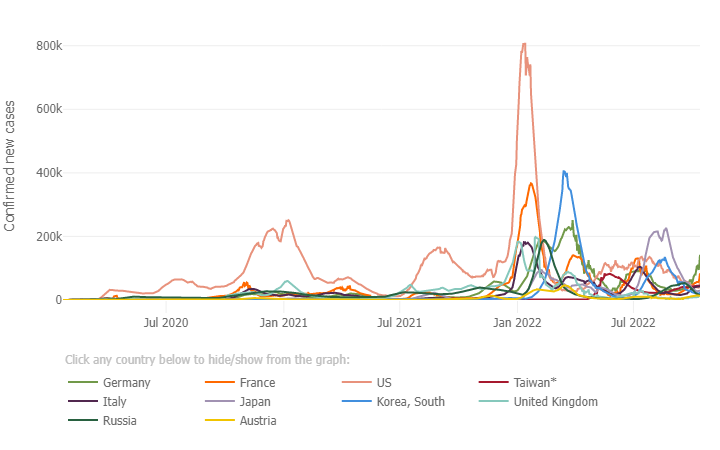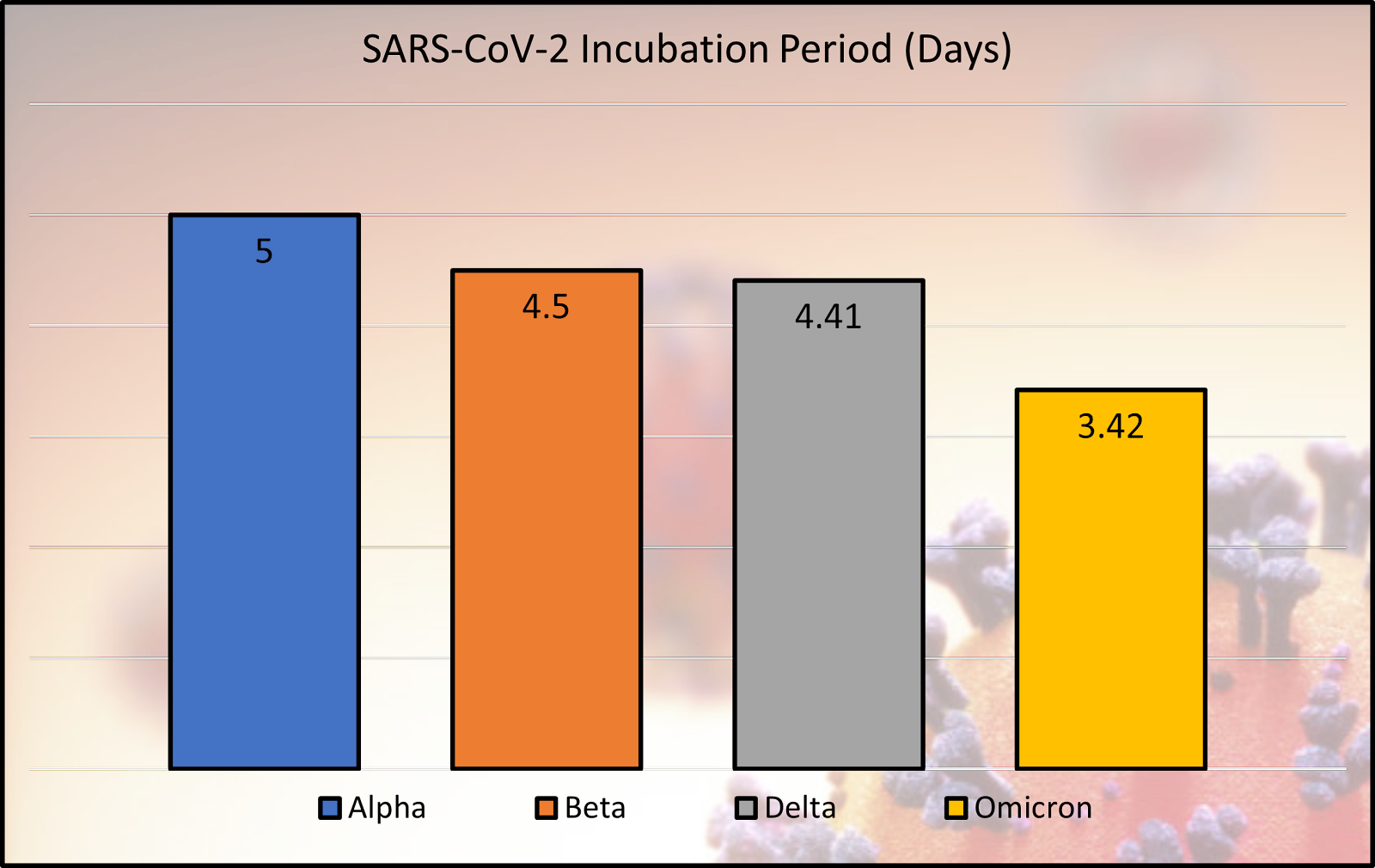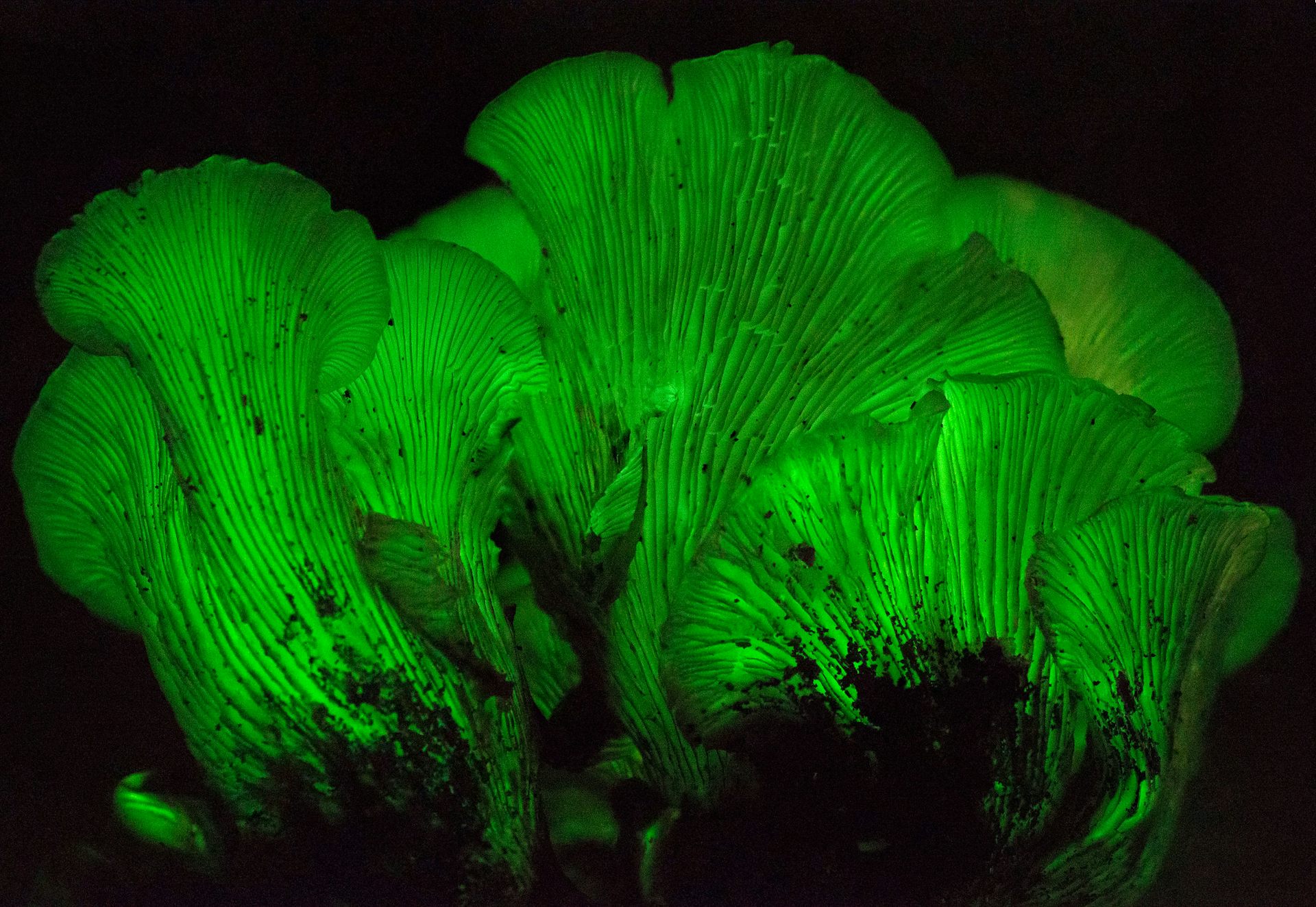Dynamic oxygen levels may have accelerated animal evolution | University of Leeds
An essential part of the Theory of Evolution is that environmental change should be reflected in evolutionary change in taxons because a changing environment is the main driver of evolution. So, if the TOE was wrong and Creationism was a better explanation for biodiversity, we would expect to see no connection between major environmental change and evolutionary change. Indeed, if Bible literalist Creationism were correct, we would not expect to see any evidence of major environmental change even, since this evidence-free superstition is that a magic deity created everything as it is today.
And yet, a research team at the University of Leeds supported by the Universities of Lyon, Exeter and UCL, has found evidence that early animals evolved on Earth in response to wildly fluctuating atmospheric oxygen levels, and in particular during the period following the 'Great Oxidation Event' which occurred some 2 billion years ago when the cyanobacteria evolved photosynthesis and began polluting the atmosphere with the process's waste product, oxygen.
In between, that and the third step about 200 million years ago when atmospheric oxygen reached todays level, there was a second step during the 500 million-year long Neoproterozoic Era which began about 1 billion years ago. Until now, what happened during that period when early forms of animals appear in the fossil record, was something of a mystery. It was during this era that the earliest multicellular life forms, Ediacaran biota, made their appearance.
As the Leeds University News release explains:
Religion, Creationism, evolution, science and politics from a centre-left atheist humanist. The blog religious frauds tell lies about.
Saturday 22 October 2022
Friday 21 October 2022
Creationism in Crisis - How The 'Designer' of Photosynthesis Tried to Improve It's Mistake and Failed Again
Back to the future of photosynthesis | Max-Planck-Gesellschaft
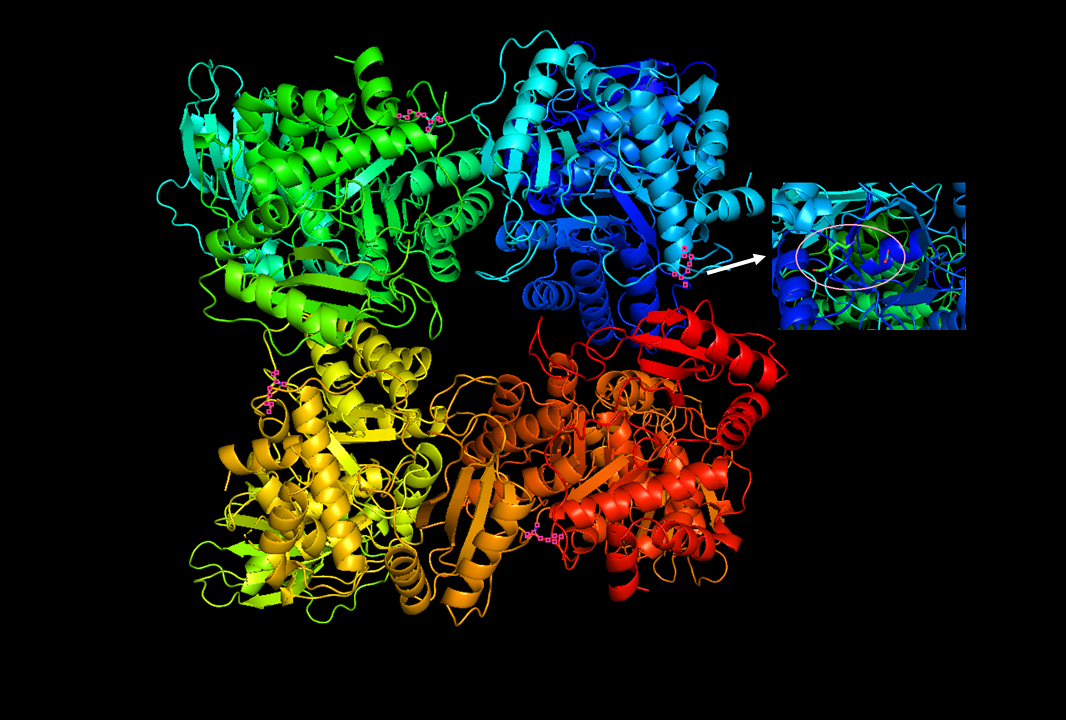 Evolution, of course, doesn't have an intelligent designer because it's a purely natural, non-sentient process involving nothing more that the operation of chemistry and physics in a selective environment. However, Creationists insist that nothing happens without god-magic and the involvement of a sentient directing entity, even though the existence of such an entity has never been demonstrated or explained, and there are no authenticated accounts of it ever making anything happen that couldn't have happened without it.
Evolution, of course, doesn't have an intelligent designer because it's a purely natural, non-sentient process involving nothing more that the operation of chemistry and physics in a selective environment. However, Creationists insist that nothing happens without god-magic and the involvement of a sentient directing entity, even though the existence of such an entity has never been demonstrated or explained, and there are no authenticated accounts of it ever making anything happen that couldn't have happened without it.
So, let’s look at the evolution of photosynthesis and especially the essential enzyme RuBisCo and the implications of recent research by a team from the Max-Planck-Institute for Terrestrial Microbiology in Marburg, Germany in collaboration with scientists from the University of Singapore.

A 3d cartoon depiction of the activated RuBisCO from spinach in open form with active site accessible. The active site Lys175 residues are marked in pink, and a close-up of the residue is provided to the right for one of the monomers composing the enzyme.
So, let’s look at the evolution of photosynthesis and especially the essential enzyme RuBisCo and the implications of recent research by a team from the Max-Planck-Institute for Terrestrial Microbiology in Marburg, Germany in collaboration with scientists from the University of Singapore.
Labels:
Botany
,
Creationism
,
Evolution
,
Nature
,
Science
,
Unintelligent Design
Nasty Party News - I Hate To Say IT But I Told You So!
WhaLiz Truss resigns as prime minister: the five causes of her downfall explained
As the Tory Party tries to recover from yet another mistake in its choice of leader, even openly discussing bringing back the mistake before last in the unappealing form of 'conviction politician', Boris Johnson, the factional infighting as Tory MPs try to decide "What's in it for me?" continues to dominate UK politics as it has done ever since they chose David Cameron. Meanwhile major problems such as increasing poverty, a collapsing NHS, almost non-existent social care, lack of affordable housing and a stagnating economy are ignored in favour of personal gain and political careers.
On the day Truss was elected, I wrote:
So, how did the oh-so-predictable failure of the Truss premiership come so quickly?
In this article, reprinted from The Conversation under a Creative Commons license, reformatted for stylistic consistency, Matthew Flinders, Founding Director of the Sir Bernard Crick Centre for the Public Understanding of Politics, University of Sheffield, suggests there were five key elements in her rise and fall. The original article can be read here:
As the Tory Party tries to recover from yet another mistake in its choice of leader, even openly discussing bringing back the mistake before last in the unappealing form of 'conviction politician', Boris Johnson, the factional infighting as Tory MPs try to decide "What's in it for me?" continues to dominate UK politics as it has done ever since they chose David Cameron. Meanwhile major problems such as increasing poverty, a collapsing NHS, almost non-existent social care, lack of affordable housing and a stagnating economy are ignored in favour of personal gain and political careers.
On the day Truss was elected, I wrote:
Liz Truss could be the latest in a long line of increasingly incompetent Tory leaders which began with John Major, followed by William Hague, Ian Duncan Smith, Michael Howard, David Cameron, Theresa May and Boris Johnson in that order. Arguably, Tory leaders have been increasingly less competent since Neville Chamberlain, interspersed only by Winston Churchill and (arguably) Margaret Thatcher, who, nasty though she was, can't really be described as incompetent, save only for the Poll Tax debacle that cost her the leadership.Little did I suspect that the interesting times would be so short and that the car crash that was Liz Truss's premiership would be so short-lived. It's almost disappointing that one of the most gratifying spectacles in UK politics - the Nasty Party if full civil war - has come to an end so soon. However, that may be an unrealistic assessment, as there is no sign yet of even a truce, as the backstabbing and manoeuvring for position is to last at least another week as the MPs choose another leader and this time try to deny the 60,000 or so party members a say. After all, they chose, in succession, Theresa May, Boris Johnson and Liz Truss, so clearly they can't be trusted to choose responsibly.
She [Truss] is something of a political balloon, going with the political wind in whatever direction furthers her career. She comes from a left-leaning family and used to go to peace camps with her socialist mother. But she chose the Tory Party to stand as an MP. In the Tory Party she was initially to the left of the party and voted ‘remain’ in the EU referendum. Having been on the losing side she quickly realised she had been a Brexiteer all along and is now an enthusiastic supporter of the idea. It remains to be seen what other principles she will be willing to abandon to retain power. As always, with Tory MPs, “What’s in it for me?” is the only principle worth holding to.
To add to her difficulties, Truss inherits a party, after a fractious and bruising leadership campaign, that is hopelessly divided on a number of issues, with a substantial number holding former Labour 'safe' seats in Northern ‘red wall’ constituencies, who are fearful of losing them at the next election, and she was elected by just 57% of the members - the smallest majority of any leader since they allowed the members a say in the matter.
She also inherits an impending financial crisis with standards of living forecast to fall by 10% in the next two years - in the lead up to the next general election, due in Spring 2024 - with soaring energy prices, zero economic growth, accelerating inflation expected to exceed 20% - levels not seen since the 1970s, increasing interest rates, and an NHS on the point of collapse, due to the 'Brexit bonus' of lots of staff in the NHS and the Social Care sectors returning to their EU home countries, having lost the right to live and work in the UK.
And the Tory Party can no longer get away with blaming everything on the previous Labour Government, having been in government themselves since 2010. Instead, they are now facing the humiliation of having to adopt some of Labour's policies if they are to tackle the impending crises. The Tories are quickly losing their reputation for economic competence, that was never really deserved anyway, having successfully blamed the Wilson/Callaghan government for the economic chaos of the 1970's caused by the 'Barber boom' under Ted Heath, which was a cynical attempt to buy popular support.
What probably won it for Truss was her promise to introduce big tax cuts, which appealed to the Tory Party members whose single political concern is always, "What's in it for me?" She is now faced with either implementing that against all the financial advice that it will do nothing for the poor, who are facing the brunt of the economic crisis, because they don't pay tax, but will be inflationary, so making the poor poorer, or reneging on a central promise to her members to make them richer at the expense of the poor.
[…]
The latest update to this story is that Truss seems to be stuffing her cabinet with those who supported her in the leadership campaign and sacking or refusing jobs to Sunak supporters. This bloodbath might make the cabinet easier to control but will leave a lot of frustrated, ambitious, and embittered Tory MPs on the back benches, when the last thing she needs is enemies. A 60-odd seat majority is no guarantee of an easy time in the Commons, as Johnson discovered. Perhaps she is merely showing her party how tough and ruthless sha can be and how she will deal with disloyalty in the future.
The next two years will be… interesting.
So, how did the oh-so-predictable failure of the Truss premiership come so quickly?
In this article, reprinted from The Conversation under a Creative Commons license, reformatted for stylistic consistency, Matthew Flinders, Founding Director of the Sir Bernard Crick Centre for the Public Understanding of Politics, University of Sheffield, suggests there were five key elements in her rise and fall. The original article can be read here:
Labels:
Frauds
,
Greed
,
Nasty Party
,
Politics
,
UK
Wednesday 19 October 2022
Malevolent Designer News - Now Creationism's Divine Malevolence is Also Killing Birds With a Virus!
What is avian flu, the disease afflicting viral TikTok emu Emmanuel?
 The COVID-19 pandemic caused by variants of the SARS-CoV-2 virus is not the only viral pandemic the world is currently experiencing. Many of the world's birds, both domesticated and wild are dying from a virus known as avian flu that is related to the virus that causes influenza in humans. Like the SARS-C0V-2, virus, the avian flu virus comes in a variety of versions and mutates to give successive waves of infection and reinfection. Also like the SARS-CoV-2 virus, avian flu is zoonotic. Two varieties in particular, H1N5 and H7N9, can be caught by humans and can cause us serious illness and even death. Not all variants kill their bird victims; some will just make them very unwell. In the case of domestic hens, it will reduce egg-laying, causing economic damage to egg producers.
The COVID-19 pandemic caused by variants of the SARS-CoV-2 virus is not the only viral pandemic the world is currently experiencing. Many of the world's birds, both domesticated and wild are dying from a virus known as avian flu that is related to the virus that causes influenza in humans. Like the SARS-C0V-2, virus, the avian flu virus comes in a variety of versions and mutates to give successive waves of infection and reinfection. Also like the SARS-CoV-2 virus, avian flu is zoonotic. Two varieties in particular, H1N5 and H7N9, can be caught by humans and can cause us serious illness and even death. Not all variants kill their bird victims; some will just make them very unwell. In the case of domestic hens, it will reduce egg-laying, causing economic damage to egg producers.
The UK bird charity, the Royal Society for the Protection of Birds (RSPB) is also reporting devastation in some UK wild bird populations, especially waterfowl and seabirds.
In the following article, Professor Marta Hernandez-Jover, Professor in Veterinary Epidemiology and Public Health at Charles Sturt University, Australia, explains what avian flu is, and what measures are being put in place in Australia to prevent outbreaks. Australia is fortunate in that migratory geese, one of the main avian orders that spread the virus, do not migrate to Australia. The article from The Conversation is reprinted under a Creative Commons License, reformatted for stylistic consistency. The original article can be read here:

Barnacle and white fronted geese arriving on the Island of Islay from Greenland.
Source: RSPB
The UK bird charity, the Royal Society for the Protection of Birds (RSPB) is also reporting devastation in some UK wild bird populations, especially waterfowl and seabirds.
In the following article, Professor Marta Hernandez-Jover, Professor in Veterinary Epidemiology and Public Health at Charles Sturt University, Australia, explains what avian flu is, and what measures are being put in place in Australia to prevent outbreaks. Australia is fortunate in that migratory geese, one of the main avian orders that spread the virus, do not migrate to Australia. The article from The Conversation is reprinted under a Creative Commons License, reformatted for stylistic consistency. The original article can be read here:
Labels:
Birds
,
Evolution
,
Malevolent Design
,
Nature
,
Science
Order From Chaos in Space - Science Exlains it

An alien magastructure?
Surely there must be an intelligence behind such an ordered structure! Read on!
Surely there must be an intelligence behind such an ordered structure! Read on!
Left: false-colour JWST/MIRI Imager observations of WR 140 taken with the F770W, F1500W and F2100W filters that correspond to blue, green and red, respectively. Eight symmetric diffraction spikes are seen around the saturated core of WR 140 (at the origin) that exhibit bluer colours than the dust emission. Right: JWST/MIRI MRS spectral data cube images of WR 140 from Channel 2 at 8.01 μm taken at two different positions that cover the central binary and shell 1 (Offset 1, top) and shells 1 and 2 (Offset 2, bottom) shown in a square-root stretch. The central binary and bright dust emission features are labelled in the MRS data cube images.
One of the Creationist cult's articles of faith is the demonstrably false assertion that you can't get order from chaos, although how they imagine raindrops form, or even more subtly, how an internal combustion engine works without the operation of the gas laws which are emergent laws from the chaotic mass action of gas molecules, is anyone's guess.
A moment's thought should tell them that, with a directional force involved, there can be no such thing as true randomness in nature. One such force is of course gravity which turns a cloud of randomly distributed gas particles into an ordered sun and maybe a planetary system. Another example is the process of natural selection which gives a non-random progress towards assorted genes in a species from the random occurrence of genetic mutations.
And here is yet another example of structure emerging naturally from chaotic dust particles in an article from The Conversation by Professor Peter Tuthill, an Astrophysicist at the University of Sydney, NSW, Australia. The article is reproduced here under a Creative Commons license, reformatted for stylistic consistency. The force in this instance is the complex pattern of gravity generated by two stars in elliptical orbit around each other in a binary system and the intense solar winds each gives off which drives regular pulses of dust from their surfaces.
The original article can be read here:
Labels:
Astronomy
,
Cosmology
,
Creationism
,
Physics
,
Science
,
Science Deniers
Tuesday 18 October 2022
Unintelligent Design - The Daft Design for Bioluminescence in a Squid
Symbiotic Organs: Extreme Intimacy with the Microbial World | TS Digest | The Scientist
Imagine for a moment that you are an intelligent designer, and your task is to provide a squid with bioluminescence - something you've done hundreds, even thousands of times in other species by giving them special enzymes and substances called phosphors. What would you do?
Well, if you’ve got any sense, you would adapt one of the hundreds of tried and tested processes you used in other species, wouldn't you? That would be the intelligent thing to do and would mean minimal complexity and maximal simplicity - two of the hall marks of good design (actually two sides of the same coin since you can't have one without the other).
But not if you're Yahweh, the creator god of the Creationist cults - the one they call an intelligent designer - a misnomer, as we shall see.
Imagine for a moment that you are an intelligent designer, and your task is to provide a squid with bioluminescence - something you've done hundreds, even thousands of times in other species by giving them special enzymes and substances called phosphors. What would you do?
Well, if you’ve got any sense, you would adapt one of the hundreds of tried and tested processes you used in other species, wouldn't you? That would be the intelligent thing to do and would mean minimal complexity and maximal simplicity - two of the hall marks of good design (actually two sides of the same coin since you can't have one without the other).
But not if you're Yahweh, the creator god of the Creationist cults - the one they call an intelligent designer - a misnomer, as we shall see.
Labels:
Biology
,
Creationism
,
Evolution
,
Science
,
Unintelligent Design
Monday 17 October 2022
Creationism in Crisis - Darwin's Finches Provide More Evidence for Speciation by Evolution
Widespread variation of inherited retroviruses among Darwin’s finches - Uppsala University, Sweden
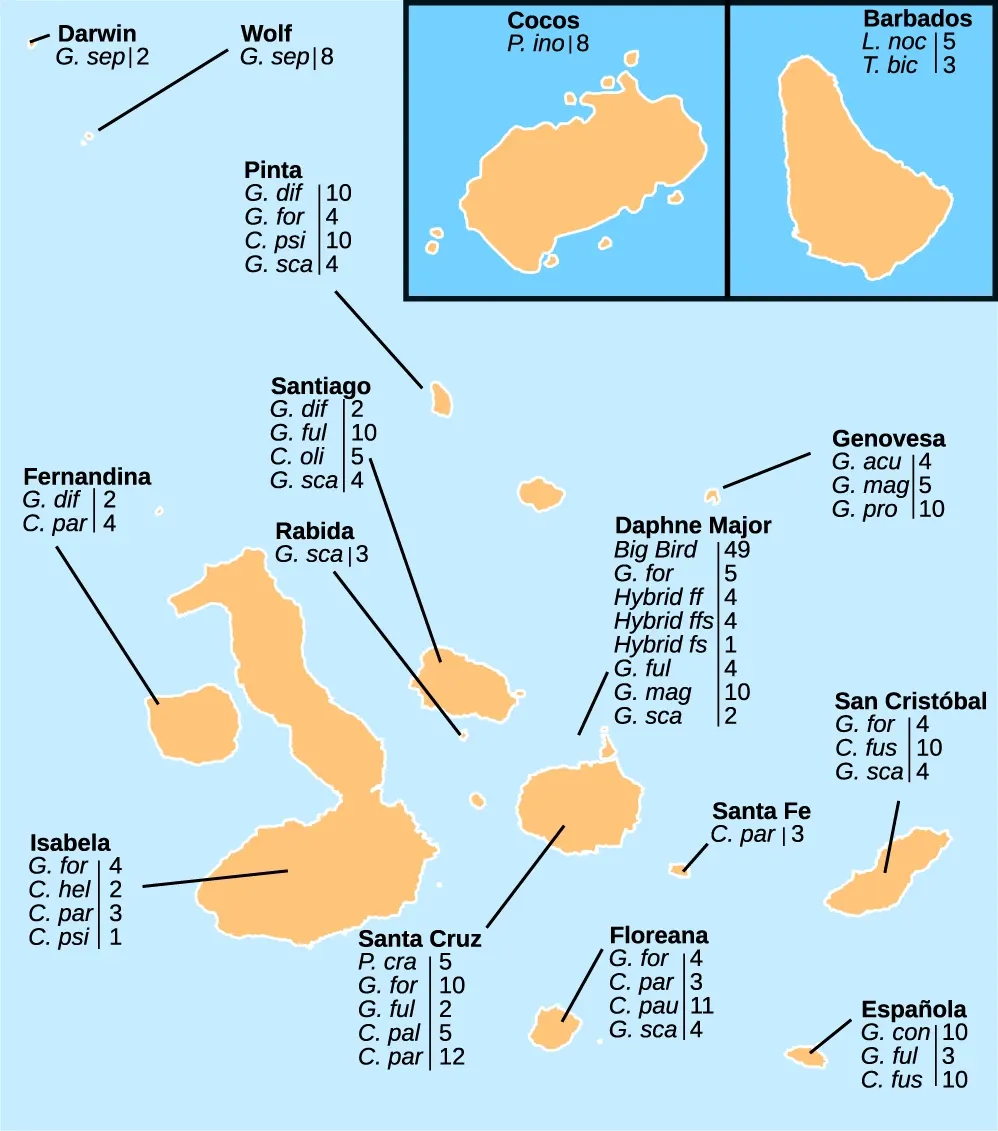 This is the sort of research that should send any dedicated Creationist into a rage, and frantically scouring their armoury of techniques for coping with cognitive dissonance, if only they understood enough of the subject to realise its implications.
This is the sort of research that should send any dedicated Creationist into a rage, and frantically scouring their armoury of techniques for coping with cognitive dissonance, if only they understood enough of the subject to realise its implications.
It's an account of how Darwin's finches were used as the basis for showing how the Theory of Evolution can explain the presence and differences in the remnants of ancient retroviruses in the genome of those finches that inspired Charles Darwin to formulate the Theory of Evolution all those years ago.

A total of 293 Darwin’s finch samples representing 18 species, 4 hybrids and 2 outgroup species (Loxigilla noctis and Tiaris bicolor) from 16 islands6,9,10,11 were included in the study. Island names are indicated above finch species, hybrids and their respective sampling sizes. Finch species abbreviations: Big Bird lineage (Geospiza fortis x Geospiza conirostris), C. fus (Certhidea fusca), C. hel (Camarhynchus heliobates), C. pal (Camarhynchus pallidus), C. par (Camarhynchus parvulus), C. pau (Camarhynchus pauper), C. psi (Camarhynchus psittacula), C. oli (Certhidea olivacea), G. acu (Geospiza acutirostris), G. con (Geospiza conirostris), G. dif (Geospiza difficilis), G. for (Geospiza fortis), G. ful (Geospiza fuliginosa), G. mag (Geospiza magnirostris), G. pro (Geospiza propinqua), G. sca (Geospiza scandens), G. sep (Geospiza septentrionalis), Hybrid ff (Hybrid G. fortis x G. fuliginosa), Hybrid ffs (Hybrid G. fortis x G. fuliginosa x G. scandens), Hybrid fs (Hybrid G. fuliginosa x G. scandens), L. noc (Loxigilla noctis), T. bic (Tiaris bicolor), P. cra (Platyspiza crassirostris), P. ino (Pinaroloxias inornata).
It's an account of how Darwin's finches were used as the basis for showing how the Theory of Evolution can explain the presence and differences in the remnants of ancient retroviruses in the genome of those finches that inspired Charles Darwin to formulate the Theory of Evolution all those years ago.
Labels:
Creationism
,
Evolution
,
Science
,
Virology
Covidiot News - How the Antivaxx Trumpanzees are Risking Your Life For Political Gain
Association of Primary and Booster Vaccination and Prior Infection With SARS-CoV-2 Infection and Severe COVID-19 Outcomes | Infectious Diseases | JAMA | JAMA Network
 More evidence was produces today showing how efficatious the anti-COVID vaccines are at preventing serious illness and death from COVID-19 and, incidentally, how dangerous and reckless has been the pro-Trump campaign to minimise the risks and raise the level of vaccine hesitancy in the US pupulation, led by Trumpanzee far-right loonies, evangelical Chritian preachers and televangelists and politically-motivated conspiracy theorists.
More evidence was produces today showing how efficatious the anti-COVID vaccines are at preventing serious illness and death from COVID-19 and, incidentally, how dangerous and reckless has been the pro-Trump campaign to minimise the risks and raise the level of vaccine hesitancy in the US pupulation, led by Trumpanzee far-right loonies, evangelical Chritian preachers and televangelists and politically-motivated conspiracy theorists.
This evidence came in the form of a paper published in JAMA Network reporting on a cohort study of 10.6 million North Carolina Residents between March 2020 and June 2022, which concluded that:
In the North Carolina cohort, only 67% of the cohort had been vaccinated. This means that one in three North Carolinans have no protection unless they have survived an earlier infection, which will provide some protection for a few months. These people can act as breeding grounds for new variants and as repositories for the virus ready to infect anyone with waning antibody levels.
The only way to reduce the effects of the pandemic on society is thus to keep the general level of protection in the population as high as possible and to reduce the number of people acting as these breeding grounds through better education to reduce the antisocial effect of the right-wing, Trumpanzee cult antivaxx disinformation campaigns.

Estimates of effectiveness are shown by solid curves, and 95% CIs are shown by shaded bands. The steep upward trends seen early in panels A-C, but not in panel D, represent the ramp-up period of vaccination. Each curve is truncated at 15 months or when the number at risk hits 15% of the relevant sample. D, Comparison of prior infection with survival to no prior infection among all participants (vaccinated and not), with 98.6% of all participants surviving the prior infection. Home testing for infection is not included. Further detail can be found in eTable 1 in the Supplement.
Source: Lin D, Gu Y, Xu Y, et al (2022).
This evidence came in the form of a paper published in JAMA Network reporting on a cohort study of 10.6 million North Carolina Residents between March 2020 and June 2022, which concluded that:
…receipt of a primary COVID-19 vaccine series compared with being unvaccinated, receipt of a booster compared with primary vaccination, and prior SARS-CoV-2 infection compared with no prior infection were all significantly associated with lower risk of SARS-CoV-2 infection and resulting hospitalization and death.In an editorial in JAMA Network accompanying publication of the paper the editor said:
The authors report that as of June 3, 2022, a total of 67% of the study population had been vaccinated and 2 771 364 SARS-CoV-2 infections were reported, with a hospitalization rate of 6.3% and mortality rate of 1.4%. Based on the analysis and findings, there are several important takeaways from this study. First, the results reinforced that first-generation COVID-19 vaccines were highly and durably effective against severe disease as measured by hospitalizations and deaths, but did not protect against milder infections beyond a few months, even with booster vaccinations. Emerging new variants, including Omicron, are associated with less protection against infection. However, even modest protection against SARS-CoV-2 infection may provide important benefits by reducing surges that can overwhelm health care systems, keeping schools and workplaces open, and protecting vulnerable populations at risk for severe outcomes following infection, including older adults and those with underlying medical conditions.In the abstrct to their paper, the authors state:
Second, prior infection was associated with a reduction in risk of infection and severe outcomes among those with or without prior vaccination. Additionally, among people with prior documented infection who had completed a primary vaccine series, booster vaccination was associated with additional protection, including 39.3% vaccine effectiveness against hospitalization after 3 months. Although prior infection alone is associated with lower risk of reinfection, vaccination also provides protection against ongoing transmission and has additional benefits, including attenuating severity of disease and reducing the risk of disabling postacute sequelae of COVID-19.9,14
Third, this study reinforced the growing complexities of COVID-19 and the strengths and limitations of routine surveillance systems. State-based surveillance systems have large sample sizes that allow detection of uncommon events and multiple subgroup analyses. However, they often lack granular details on underlying medical conditions or other factors that allow for better control of confounding or effect modification. Lin et al found that waning of booster dose vaccine effectiveness occurred over 4 to 6 months, but this may be partially due to patients with certain high-risk conditions, such as those who are significantly immunocompromised, getting third doses earlier than the general population. Among individuals who received a primary mRNA vaccine series, understanding comparability between those who received homologous and heterologous mRNA boosters would also be helpful to strengthen inference around benefits of receiving mixed vaccine products that was observed in this study.
Key PointsThe benefits of vaccination and the risk of not being vaccinated is now unarguable, but the final sentence emphasises the importance of regular boosters as and when they become available, especially of those which have been updated to protect against the latest variants and subvarients. Pending a definitive vaccine against all SARS-C0V-2 virus strains, there is no real alternative but the keep our defences high with these regular boosters, much like we are currently doing with the influenza viruses where anual vaccination is needed because the virus readily mutates to form new varieties which can evade the immunity in the pupulation from the last wave of infections.
Question How does the association of COVID-19 vaccination and prior SARS-CoV-2 infection with subsequent SARS-CoV-2 infection and severe COVID-19 outcomes change over time?
Findings In a cohort study of 10.6 million North Carolina residents from March 2020 to June 2022, receipt of a primary COVID-19 vaccine series compared with being unvaccinated, receipt of a booster compared with primary vaccination, and prior SARS-CoV-2 infection compared with no prior infection were all significantly associated with lower risk of SARS-CoV-2 infection and resulting hospitalization and death. The estimates for the associated protection decreased over time, especially for the outcome of infection, and varied by type of circulating variant.
Meaning Receipt of COVID-19 vaccines and boosters, as well as prior SARS-CoV-2 infection, were associated with protection against SARS-CoV-2 infection (including Omicron) and severe COVID-19 outcomes, although the associated protection waned over time.
Abstract
Importance Data about the association of COVID-19 vaccination and prior SARS-CoV-2 infection with risk of SARS-CoV-2 infection and severe COVID-19 outcomes may guide prevention strategies.
Objective To estimate the time-varying association of primary and booster COVID-19 vaccination and prior SARS-CoV-2 infection with subsequent SARS-CoV-2 infection, hospitalization, and death.
Design, Setting, and Participants Cohort study of 10.6 million residents in North Carolina from March 2, 2020, through June 3, 2022.
Exposures COVID-19 primary vaccine series and boosters and prior SARS-CoV-2 infection.
Main Outcomes and Measures Rate ratio (RR) of SARS-CoV-2 infection and hazard ratio (HR) of COVID-19–related hospitalization and death.
Results The median age among the 10.6 million participants was 39 years; 51.3% were female, 71.5% were White, and 9.9% were Hispanic. As of June 3, 2022, 67% of participants had been vaccinated. There were 2 771 364 SARS-CoV-2 infections, with a hospitalization rate of 6.3% and mortality rate of 1.4%. The adjusted RR of the primary vaccine series compared with being unvaccinated against infection became 0.53 (95% CI, 0.52-0.53) for BNT162b2, 0.52 (95% CI, 0.51-0.53) for mRNA-1273, and 0.51 (95% CI, 0.50-0.53) for Ad26.COV2.S 10 months after the first dose, but the adjusted HR for hospitalization remained at 0.29 (95% CI, 0.24-0.35) for BNT162b2, 0.27 (95% CI, 0.23-0.32) for mRNA-1273, and 0.35 (95% CI, 0.29-0.42) for Ad26.COV2.S and the adjusted HR of death remained at 0.23 (95% CI, 0.17-0.29) for BNT162b2, 0.15 (95% CI, 0.11-0.20) for mRNA-1273, and 0.24 (95% CI, 0.19-0.31) for Ad26.COV2.S. For the BNT162b2 primary series, boosting in December 2021 with BNT162b2 had the adjusted RR relative to primary series of 0.39 (95% CI, 0.38-0.40) and boosting with mRNA-1273 had the adjusted RR of 0.32 (95% CI, 0.30-0.34) against infection after 1 month and boosting with BNT162b2 had the adjusted RR of 0.84 (95% CI, 0.82-0.86) and boosting with mRNA-1273 had the adjusted RR of 0.60 (95% CI, 0.57-0.62) after 3 months. Among all participants, the adjusted RR of Omicron infection compared with no prior infection was estimated at 0.23 (95% CI, 0.22-0.24) against infection, and the adjusted HRs were 0.10 (95% CI, 0.07-0.14) against hospitalization and 0.11 (95% CI, 0.08-0.15) against death after 4 months.
Conclusions and Relevance Receipt of primary COVID-19 vaccine series compared with being unvaccinated, receipt of boosters compared with primary vaccination, and prior infection compared with no prior infection were all significantly associated with lower risk of SARS-CoV-2 infection (including Omicron) and resulting hospitalization and death. The associated protection waned over time, especially against infection.
Lin D, Gu Y, Xu Y, et al.
Association of Primary and Booster Vaccination and Prior Infection With SARS-CoV-2 Infection and Severe COVID-19 Outcomes.
JAMA. 2022;328(14):1415–1426. doi:10.1001/jama.2022.17876
© 2022 American Medical Association.
Reprinted under the terms of the Copyright, Designs and Patents Act 1988, s60.
In the North Carolina cohort, only 67% of the cohort had been vaccinated. This means that one in three North Carolinans have no protection unless they have survived an earlier infection, which will provide some protection for a few months. These people can act as breeding grounds for new variants and as repositories for the virus ready to infect anyone with waning antibody levels.
The only way to reduce the effects of the pandemic on society is thus to keep the general level of protection in the population as high as possible and to reduce the number of people acting as these breeding grounds through better education to reduce the antisocial effect of the right-wing, Trumpanzee cult antivaxx disinformation campaigns.
Covidiot News - Stunning Sucess for the Trumpanzee Antivaxx Self-Genocide Campaign as US Life Expectancy Falls
Lowest US Life Expectancy Since 1996 Linked to COVID-19 | Population Health | JAMA | JAMA Network
A new report a few days ago from the US National Center for Health Statistics shows that life expectancy dropped by 3 years to about 73 for US men and 2.3 years to about 79 years for US women between 2019 and 2021. These are the lowest figures since 1996 after years of steadily increasing life expectancy for new-born babies.
Over the same period, the gap in life expectancy between men and women in the USA, which had been closing, widened again from 4.8 years in 2010 (the smallest recorded) to 6 years in 2021.
Despite the desperate claims of Trump-supporting evangelical preachers, far right extremists and conspiracy loons that COVID-19 was variously a hoax, a mild infection no worse than flu and could easily be prevented or cured with readily available drugs, without the need for 'dangerous' vaccines, three-quarters of over-all life expectancy lost during this period was attributed to COVID-19 deaths, according to a CDC statement.
Possibly due to the measures to combat the spread of COVID-19 such as wearing face covering, social distancing and lockdowns, deaths from influenza and other, non-COVID respiratory infections fell during the period, helping to offset some of the declining life expectancy.
There were also significant racial/ethnic and gender difference in the fall in life expectancy. According to the CDC report:
A new report a few days ago from the US National Center for Health Statistics shows that life expectancy dropped by 3 years to about 73 for US men and 2.3 years to about 79 years for US women between 2019 and 2021. These are the lowest figures since 1996 after years of steadily increasing life expectancy for new-born babies.
Over the same period, the gap in life expectancy between men and women in the USA, which had been closing, widened again from 4.8 years in 2010 (the smallest recorded) to 6 years in 2021.
Despite the desperate claims of Trump-supporting evangelical preachers, far right extremists and conspiracy loons that COVID-19 was variously a hoax, a mild infection no worse than flu and could easily be prevented or cured with readily available drugs, without the need for 'dangerous' vaccines, three-quarters of over-all life expectancy lost during this period was attributed to COVID-19 deaths, according to a CDC statement.
Possibly due to the measures to combat the spread of COVID-19 such as wearing face covering, social distancing and lockdowns, deaths from influenza and other, non-COVID respiratory infections fell during the period, helping to offset some of the declining life expectancy.
There were also significant racial/ethnic and gender difference in the fall in life expectancy. According to the CDC report:
Labels:
Covid-19
,
Covidiots
,
Cults
,
Gullibility
,
Health
,
Trumpanzees
Saturday 15 October 2022
Malevolent Designer News - How Creationism Divine Malevolence is Ahead of Medical Science
2022 News - Other SARS-CoV-2 Proteins are Important for Disease Severity, Aside from the Spike | University of Maryland School of Medicine
These must be such thrilling times for Creationists as almost every day scientists discover yet more evidence of the ingenuity of their putative divine malevolence in is design (and continuous redesign) of its SARS-CoV-2 virus that is still killing tens of thousands of people daily with COVID-19. Only recently it was announced that the equivalent of a jumbo jet full of people are being killed every day by it in the USA alone.
To date (14 Oct. 2022) an estimated 624,161,610 people have been infected, of which 6,565,979 have died, 1,064,910 of those in the USA alone. Several countries are experiencing yet another wave of infections and there is reported to be an even more dangerous variant (BA.2.75.2) waiting in the wings.
And today’s piece of thrilling news for devotees of this putative pestilential sadist and habitual serial killer, is that it's not just the spike proteins that give the virus it's virulence, but another protein that the vaccines don't reach, but which can inhibit our immune response. The malevolent designer obviously anticipated medical science's response to the pandemic and built in a way round the defences medical science was going to give us, if you’ve fallen for the intelligent [sic] design hoax, that is..
The current predominant variant is the BA.5 subvariant of the Omicron variant. This has recently replaced the BA.4 subvariant by out-competing it for human resources. Both these variants are able to evade most of the antibodies our immune system raises after vaccination or following infection because the antibodies are produced against the spike proteins. This means vaccination and/or previous infection are less effective. However, both BA.4 and BA.5 have identical genes for the spike proteins so BA.5's advantage must come from somewhere other than those spike protein genes.
These must be such thrilling times for Creationists as almost every day scientists discover yet more evidence of the ingenuity of their putative divine malevolence in is design (and continuous redesign) of its SARS-CoV-2 virus that is still killing tens of thousands of people daily with COVID-19. Only recently it was announced that the equivalent of a jumbo jet full of people are being killed every day by it in the USA alone.
To date (14 Oct. 2022) an estimated 624,161,610 people have been infected, of which 6,565,979 have died, 1,064,910 of those in the USA alone. Several countries are experiencing yet another wave of infections and there is reported to be an even more dangerous variant (BA.2.75.2) waiting in the wings.
And today’s piece of thrilling news for devotees of this putative pestilential sadist and habitual serial killer, is that it's not just the spike proteins that give the virus it's virulence, but another protein that the vaccines don't reach, but which can inhibit our immune response. The malevolent designer obviously anticipated medical science's response to the pandemic and built in a way round the defences medical science was going to give us, if you’ve fallen for the intelligent [sic] design hoax, that is..
What is interesting is that both BA.4 and BA.5 variants have the same genetic sequence for the spike protein. This means it’s the other genes, the non-spike protein genes, that seem to affect the way the virus copies itself and causes disease. So, mutations in these other accessory genes are what has allowed variants like BA.5 to outcompete the earlier versions of the virus.
Professor Matthew Frieman, PhD, co-lead author.
Alicia and Yaya Foundation Professor of Viral Pathogen Research
The Department of Microbiology & Immunology
University of Maryland School of Medicine, Baltimore, MD, USA.
Alicia and Yaya Foundation Professor of Viral Pathogen Research
The Department of Microbiology & Immunology
University of Maryland School of Medicine, Baltimore, MD, USA.
Labels:
Biology
,
Covid-19
,
Creationism
,
Evolution
,
Health
,
Malevolent Design
,
Science
,
Virology
Friday 14 October 2022
Creationism in Crisis - Another Bad Day for the Cult as Scientists Use the TOE to Understand Viral Diversity
NLM Researchers Build Understanding of the Virus Universe Using Metatranscriptome Mining
A large team of researchers from the National Library of Medicine (NLM) and collaborators from multiple institutions and the RNA Virus Discovery Consortium, have discovered new bacteriophage viruses including a variety of new clades that shed light on the evolution of viruses.
Despite the repeated claims of Creationist frauds, there is no sign of the Theory of Evolution being abandoned in favour of a bronze Age superstition involving magic, an unproven entity with no known modus operandum, and 'unknowable mysteries', the scientists interpret their findings using the TOE as the established scientific theory which best explains biodiversity, without the need for anything other than the operation of natural processes.
The study was conducted by data mining the results of 5,150 diverse metatranscriptomes which together contained the sequenced RNA of 2.5 million RNA viruses. The discoveries include viruses from several new taxons including two groups which constitute entirely new phyla.
The scientists have published their findings in the online journal Cell:
A large team of researchers from the National Library of Medicine (NLM) and collaborators from multiple institutions and the RNA Virus Discovery Consortium, have discovered new bacteriophage viruses including a variety of new clades that shed light on the evolution of viruses.
The most notable discovery is the dramatic increase in the number and diversity of viruses infecting bacteria that are shown to account for a much greater fraction of RNA viruses than we previously thought.
Dr. Eugene. V. Koonin, PhD, a co-author
National Center for Biotechnology Information
National Library of Medicine
National Institutes of Health, Bethesda, MD, USA
National Center for Biotechnology Information
National Library of Medicine
National Institutes of Health, Bethesda, MD, USA
The study was conducted by data mining the results of 5,150 diverse metatranscriptomes which together contained the sequenced RNA of 2.5 million RNA viruses. The discoveries include viruses from several new taxons including two groups which constitute entirely new phyla.
The scientists have published their findings in the online journal Cell:
Labels:
Creationism
,
Evolution
,
Gullibility
,
Nature
,
Science
,
Virology
Declining Religion in USA - Latinos Are Leaving the Catholic Church
New poll finds 4 in 10 non-Catholic Latinos were once Catholic and left
Tucked away on page 15 of the NBC News/Telemundo National Survey report conducted over Sept. 17-26, 2022 by Hart Research Associates/Public Opinion Strategies, is a table that should spread despondency in the US Catholic Church, which had been pinning its hopes of avoiding the haemorrhage of members experience by other Christian churches in the USA, by the immigration of Hispanic people, assumed to be overwhelmingly Catholic.
Tucked away on page 15 of the NBC News/Telemundo National Survey report conducted over Sept. 17-26, 2022 by Hart Research Associates/Public Opinion Strategies, is a table that should spread despondency in the US Catholic Church, which had been pinning its hopes of avoiding the haemorrhage of members experience by other Christian churches in the USA, by the immigration of Hispanic people, assumed to be overwhelmingly Catholic.
Labels:
Catholics
,
Christians
,
Politics
,
Repugnicans
,
USA
Thursday 13 October 2022
Pale Blue Dot - Stunning Photos of Earth from Space
These stunning satellite images look like abstract art – and they reveal much about our planet
As a change from exposing the dishonesty and gullibility of creationists and the cynically fraudulent false claims and blatant anti-science, politically-motivated propaganda of their cult leaders, I thought it would be good to see some amazing photographs of our beautiful home in the cosmos, the planet Earth, as seen from space.
This article by Emily Finch of Monash University, Australia, is reprinted from The Conversation's Photos from the Field series, under a Creative Commons license, reformatted for stylistic consistency. The original article can be read here:
As a change from exposing the dishonesty and gullibility of creationists and the cynically fraudulent false claims and blatant anti-science, politically-motivated propaganda of their cult leaders, I thought it would be good to see some amazing photographs of our beautiful home in the cosmos, the planet Earth, as seen from space.
This article by Emily Finch of Monash University, Australia, is reprinted from The Conversation's Photos from the Field series, under a Creative Commons license, reformatted for stylistic consistency. The original article can be read here:
Unintelligent Designer News - Another Design Without a Purpose

Two life stages of 'amphibious fungi' Outside gut: on host excrement (left), Inside gut: yeast-like growth (right)
Design is what links creativity and innovation. It shapes ideas to become practical and attractive propositions for users or customers. Design may be described as creativity deployed to a specific end.
Sir George Cox - What is Design and Why It Matters
Complexity versus simplicity is a common design tradeoff. Complexity always has a cost. As such, complexity is ideally minimized for equivalent functionality and quality… Adding complexity without adding functionality or quality is known as needless complexity. Complexity can be exciting and it is possible to get involved in making technologies, communications or ideas complex for the sake of complexity. Generally, this is a mistake as complexity costs more to develop, support and useIt's clear from these definitions of good design that good, intelligent, design is practical and has to suit the specific needs of the user or client. In other words, the thing being designed must have a clear purpose. It should also be minimally complex and maximally simple.
John Spacy, Design Expert - Design: Complexity vs Simplicity.
But what of purpose in the design of living organisms?
Labels:
Biology
,
Creationism
,
Cults
,
Evolution
,
Science
,
Unintelligent Design
Wednesday 12 October 2022
A Creationist Nightmare Plant - Malevolent Design AND Evolution by Loss of Genes and Complexity

Geosiris australiensis
Source: Grey & Lee (2017)
Readers may remember how I recently described one of the most important symbiotic relationships on Earth - that between trees and fungi - as a classic example of how cooperation can evolve by the interaction of 'selfish' genes with other genes in their environment.
Creationists looking at that same relationship will insist that it is evidence of intelligent [sic] design, without ever providing evidence that such a designer entity has ever existed, any plausible mechanism by which it could have arisen without a designer, or a single, authenticated example of it ever having made chemistry and/or physics do something they couldn’t do without it.
Nevertheless, despite these shortcomings of their superstition, which means it isn't even a theory in the scientific sense, it satisfies their desire for easy answers, conforms with what their mummy and daddy believed, and avoids all that tiresome learning. Their conclusion is, therefore, that it must be true because it passes their "What do I want to be true?" test.
This article then will spoil that smugly self-satisfying conclusion on at least three counts:
- It shows any designer of this example to be a malevolent cheat who favours free-loading parasites.
- It involves evolution by loss of genes - something Creationist dogma claims is impossible in the erroneous belief that loss of information and loss of complexity are always deleterious, even though they are commonplace in successful parasites.
- It involves plate tectonics and an old Earth to explain how this example from Australia is related to species from Madagascar and the Comoro Islands.
Those Creationists who are afraid of even considering whether they could be wrong in case they upset an invisible, mind-reading, magic sky man, should probably stop reading now.
The following article by Elizabeth Joyce of James Cook University, Australia, reprinted from The Conversation under a Creative Commons license, reformatted for stylistic consistency, concerns a recently-discovered Australian parasitic plant that freeloads on the symbiotic relationship between fungi and plants by stealing the nutrients from the photosynthetic plant but giving nothing back. The original article can be read here:
Labels:
Biology
,
Botany
,
Evolution
,
Malevolent Design
,
Parasitism
,
Science
Evolution News - Why Are There 'Living Fossils?'
From coelacanths to crinoids: these 9 'living fossils' haven't changed in millions of years
Here is a article that Creationists can use to make fools of themselves with by showing they don't understand the subject about which they consider themselves to be leading experts.
It is about the so-called 'living fossils' - species that have remained superficially unchanged for tens, even hundreds of millions of years. I say superficially because there is no way to know how much evolution has occurred because we don't have samples of the species' DNA from millions of years ago, so we only have the physical appearance to go by and a great deal of evolution happens in genes that control the physiology or soft tissue and birdsstructures, not in the hard body-parts that more easily fossilise.
The other thing that Creationists make fools of themselves with is their naive assumption that there must be some rule in the Theory of Evolution which says species evolve at a more or less constant rate, so remaining unchanged means the TOE is wrong, conveniently forgetting that the handful of 'living fossils' are dwarfed by the millions of species with evidence of evolutionary change in just a few million years, including all living and extinct mammals and birds.
In the following article, the first thing to note is that all the examples of 'living fossils' are marine creatures, most of which inhabit the deep ocean floor or even buried in it. Away from mid-ocean ridges and the subduction zones around the edges of land masses, this is one of the most stable environments on Earth.
Since the primary driver of evolution is environmental change and maladaptation, producing opportunities for environmental selectors to select for or against genetic variations, a stable environment and/or near perfect adaptation means there will be little or no pressure to evolve. This is not a fault with the theory but a confirmation of it, in that it predicts that environmental change will drive evolutionary change, so it follows that environmental stability will result in little or no evolutionary change.
Here then is a sample of these 'living fossils' in an article from The Conversation by Alice Clement, Research Associate in the College of Science and Engineering, Flinders University, Australia. It is reprinted here under a Creative Commons license, reformatted for stylistic consistency. The original article can be read here:
Here is a article that Creationists can use to make fools of themselves with by showing they don't understand the subject about which they consider themselves to be leading experts.
It is about the so-called 'living fossils' - species that have remained superficially unchanged for tens, even hundreds of millions of years. I say superficially because there is no way to know how much evolution has occurred because we don't have samples of the species' DNA from millions of years ago, so we only have the physical appearance to go by and a great deal of evolution happens in genes that control the physiology or soft tissue and birdsstructures, not in the hard body-parts that more easily fossilise.
The other thing that Creationists make fools of themselves with is their naive assumption that there must be some rule in the Theory of Evolution which says species evolve at a more or less constant rate, so remaining unchanged means the TOE is wrong, conveniently forgetting that the handful of 'living fossils' are dwarfed by the millions of species with evidence of evolutionary change in just a few million years, including all living and extinct mammals and birds.
In the following article, the first thing to note is that all the examples of 'living fossils' are marine creatures, most of which inhabit the deep ocean floor or even buried in it. Away from mid-ocean ridges and the subduction zones around the edges of land masses, this is one of the most stable environments on Earth.
Since the primary driver of evolution is environmental change and maladaptation, producing opportunities for environmental selectors to select for or against genetic variations, a stable environment and/or near perfect adaptation means there will be little or no pressure to evolve. This is not a fault with the theory but a confirmation of it, in that it predicts that environmental change will drive evolutionary change, so it follows that environmental stability will result in little or no evolutionary change.
Here then is a sample of these 'living fossils' in an article from The Conversation by Alice Clement, Research Associate in the College of Science and Engineering, Flinders University, Australia. It is reprinted here under a Creative Commons license, reformatted for stylistic consistency. The original article can be read here:
Tuesday 11 October 2022
Malevolent Designer News - How the SARS-CoV-2 Virus is Getting Better at Making You Sick More Quickly
Incubation Period of COVID-19 Caused by Unique SARS-CoV-2 Strains: A Systematic Review and Meta-analysis | Infectious Diseases | JAMA Network Open | JAMA Network
A meta-analysis by scientists from the School of Public Health, Peking University, Beijing, China and Vanke School of Public Health, Tsinghua University, Beijing, China, has revealed just how sneaky Creationism's favourite pestilential designer has been with it variants of the SARS-CoV-2 virus - if you subscribe to that childish Bronze Age superstition, that is.
This meta-analysis of 141 relevant articles shows that, as well as becoming more virulent and more easily transmitted from person to person, the variant had a progressively shortening incubation period.
This might seem counter-intuitive because a slow incubation period means that a carrier remains asymptomatic for longer and so is more likely to spread the infection without realising they are infected. However, a short incubation period before it starts destroying cells in earnest also means the virus gets established more quickly and produces lots of new virus particles to be shed into the environment much sooner, and often before the victim's immune system has had time to react to it.
So, there is a trade-off between long incubation and asymptomatic spread and the short incubation and the number of virus particles being shed. It seems the balance tipped towards shorter incubation.
The analysis showed that "the incubation periods of COVID-19 caused by the Alpha, Beta, Delta, and Omicron variants were 5.00, 4.50, 4.41, and 3.42 days, respectively."
A meta-analysis by scientists from the School of Public Health, Peking University, Beijing, China and Vanke School of Public Health, Tsinghua University, Beijing, China, has revealed just how sneaky Creationism's favourite pestilential designer has been with it variants of the SARS-CoV-2 virus - if you subscribe to that childish Bronze Age superstition, that is.
This meta-analysis of 141 relevant articles shows that, as well as becoming more virulent and more easily transmitted from person to person, the variant had a progressively shortening incubation period.
This might seem counter-intuitive because a slow incubation period means that a carrier remains asymptomatic for longer and so is more likely to spread the infection without realising they are infected. However, a short incubation period before it starts destroying cells in earnest also means the virus gets established more quickly and produces lots of new virus particles to be shed into the environment much sooner, and often before the victim's immune system has had time to react to it.
So, there is a trade-off between long incubation and asymptomatic spread and the short incubation and the number of virus particles being shed. It seems the balance tipped towards shorter incubation.
The analysis showed that "the incubation periods of COVID-19 caused by the Alpha, Beta, Delta, and Omicron variants were 5.00, 4.50, 4.41, and 3.42 days, respectively."
Labels:
Covid-19
,
Creationism
,
Evolution
,
Health
,
Malevolent Design
Monday 10 October 2022
Malevolent Designer News - Creationism's Divine Malevolence is all Set for a Major Comeback with COVID-19 AND Influenza

H3N2 virus.
Despite appearances H3N2 is not closely related to SARS-CoV-2 but simultaneous infection with both can be especially dangerous
Creationism's malevolent designer is not one to be defeated easily, as we saw with its response to the anti-SARS-CoV-2 virus vaccines produced by medical science to help control the COVid-19 pandemic, where it came up with all manner of variant to get around the social distancing measures and the vaccines, and we're still not through it yet despite the political pressure to return to pre-pandemic ways.
The equivalent of a jumbo jet full of people still dies from COVID-19 every day in the USA. Can you imagine the outcry if a real jumbo jet crashed killing everyone on board every day? How many people would continue to fly and demand the government stop whatever they're doing to prevent these crashes?
Now, though, with the sensible measures like social distances, wearing face coverings and regular hand cleansing with alcohol jells just about being ignored, Creationism's divine malevolence has the ground prepared for a double whammy.
A double whammy?
The same measures that were intended to mitigate the effects of the pandemic in 2020 and 2021 were also very effective against the influenza viruses that normally do the rounds in the winter months, with the result that the numbers dying or being made seriously ill during 2020 and 2021 were very significantly down on a normal year and the number of people being infected and building up their natural immunity also fell.
In addition, as complacency spreads and less people bother with COVID-19 boosters, what 'herd immunity' there was is also diminishing fast. A recent study in Barcelona showed that, even with a vaccine and having had an infection, most people's antibody level will be virtually undetectable in 12 months, unless boosted with further vaccinations.
Another recent study identified a new sub-strain of the SARS-CoV-2 omicron variant (BA.2.75.2) which can evade most of the antibodies provided by infection and vaccination. We don't know which new strain will produce the next wave, because it depends on several factors such as infectivity, incubation period and asymptomatic transmission, but BA.2.75.2 is a good candidate
Sunday 9 October 2022
Malevolent Design News - Is Creationism's Divine Malevolence Already Modifying the Monkeypox Virus?
The monkeypox virus is mutating. Are scientists worried?
 Researchers at the Minnesota Department of Health in St. Paul have discovered that the monkeypox virus is showing signs of some radical modifications to its DNA. Being a DNA virus, it has mechanisms for repairing 'mistakes' in its genome when it replicates, which means it evolves much more slowly than, say, the SARS-CoV-2 virus which is an RNA virus and can mutate quickly and frequently, as we are witnessing with the proliferation of new variants.
Researchers at the Minnesota Department of Health in St. Paul have discovered that the monkeypox virus is showing signs of some radical modifications to its DNA. Being a DNA virus, it has mechanisms for repairing 'mistakes' in its genome when it replicates, which means it evolves much more slowly than, say, the SARS-CoV-2 virus which is an RNA virus and can mutate quickly and frequently, as we are witnessing with the proliferation of new variants.
But the mutations discovered by the Minnesota team in the monkeypox virus appear to have escaped this repair mechanism and involve deletion of whole chunks of DNA and rearrangement of other parts. The discovery was made in the course of routine sequencing of the virus DNA from a patient with the disease, and was subsequently verified by Crystal Gigante, a microbiologist at the US Centers for Disease Control and Prevention in Atlanta, Georgia, who was called in to help with the investigation.
The good news is that the mutations so far don't involve the part of the DNA which codes for the protein which is the target of tecovirimat, an antiviral drug being tested for use against monkeypox in humans.

The monkeypox virus (particles shown in this coloured image from a transmission electron microscope) is a DNA virus that readily detects and repairs small mutations in its genome, so it evolves more slowly than other pathogens.
Credit: National Institutes of Health/Science Photo Library
But the mutations discovered by the Minnesota team in the monkeypox virus appear to have escaped this repair mechanism and involve deletion of whole chunks of DNA and rearrangement of other parts. The discovery was made in the course of routine sequencing of the virus DNA from a patient with the disease, and was subsequently verified by Crystal Gigante, a microbiologist at the US Centers for Disease Control and Prevention in Atlanta, Georgia, who was called in to help with the investigation.
The good news is that the mutations so far don't involve the part of the DNA which codes for the protein which is the target of tecovirimat, an antiviral drug being tested for use against monkeypox in humans.
Labels:
Biology
,
Creationism
,
Evolution
,
Health
,
Malevolent Design
,
Science
Saturday 8 October 2022
Biodiversity News - How Trees and Fungi Need Each Other and We Need Both
The ancient, intimate relationship between trees and fungi, from fairy toadstools to technicolour mushrooms
One of the most important symbiotic relationships on the planet is that between trees and fungi, without which we would have no trees, no forests, no timber, less oxygen and according to climatologists, very different weather patterns.
We would also not have all the species that depend on trees and forests which support one of the most diverse biota on the planet.
Trees themselves are an example of unintelligent design, as I explain in my book, The Unintelligent Designer: Refuting the Intelligent Design Hoax because their trunks and branches are the result of a massively wasteful arms race, as each tree competes with its neighbours to get its leaves above the canopy and into the sunlight. The result is a massive waste of energy and resource to build a structure which would have been unnecessary, had the ancestors of today's trees all being intelligently designed to stay at ground level and not compete for resources.
As a result of this unnecessary and wasteful complexity, another layer of complexity in the form of this symbiotic relationship between trees and fungi, which makes this possible, has evolved. Without it, trees could not obtain the nutrients they need or pump the water the leaves need to the top of the structure. So, from the perspective of the notion of intelligent [sic] design, we have massive waste and needless complexity to solve problems of the designer’s own incompetent making. So this relationship between fungi and trees represents one of the most glaring examples of the lack of foresight, planning and intelligence in whatever the design process behind it was.
From an evolutionary perspective, however, there is no need to explain bad design since there is no design process, as any intelligent person would understand it, involved. The result put the evolution of life on Earth on a trajectory that resulted in what we see today, and on which thousands of species are now dependent having evolved specialisations fitting them to live and survive in those niches by a process of co-evolving co-dependency - a predictable consequence of the process of evolution by natural selection.
The symbiotic relationship is between the roots of trees and the fungal hyphae in the soil, known as mycorrhizas. It is a lovely example of how Richard Dawkin's 'selfish genes' will form mutually beneficial alliances with the genomes of two or more organisms behaving like a single genome, albeit stored in different cells, co-evolving an every closer relationship, not of wasteful competition but of the more efficient cooperation, because cooperation benefits both organisms.
In another of the The Conversation series, 'Photos from the Field', Doctor Gregory Moore of The University of Melbourne and Associate Professor Mark Brundrett of the School of Biological Sciences, The University of Western Australia, explain this relationship, its evolutionary origins and why it is so important to the ecology of the planet. The open access article is reproduced here under a Creative Commons licence, reformatted for stylistic consistency. The original article can be read here:

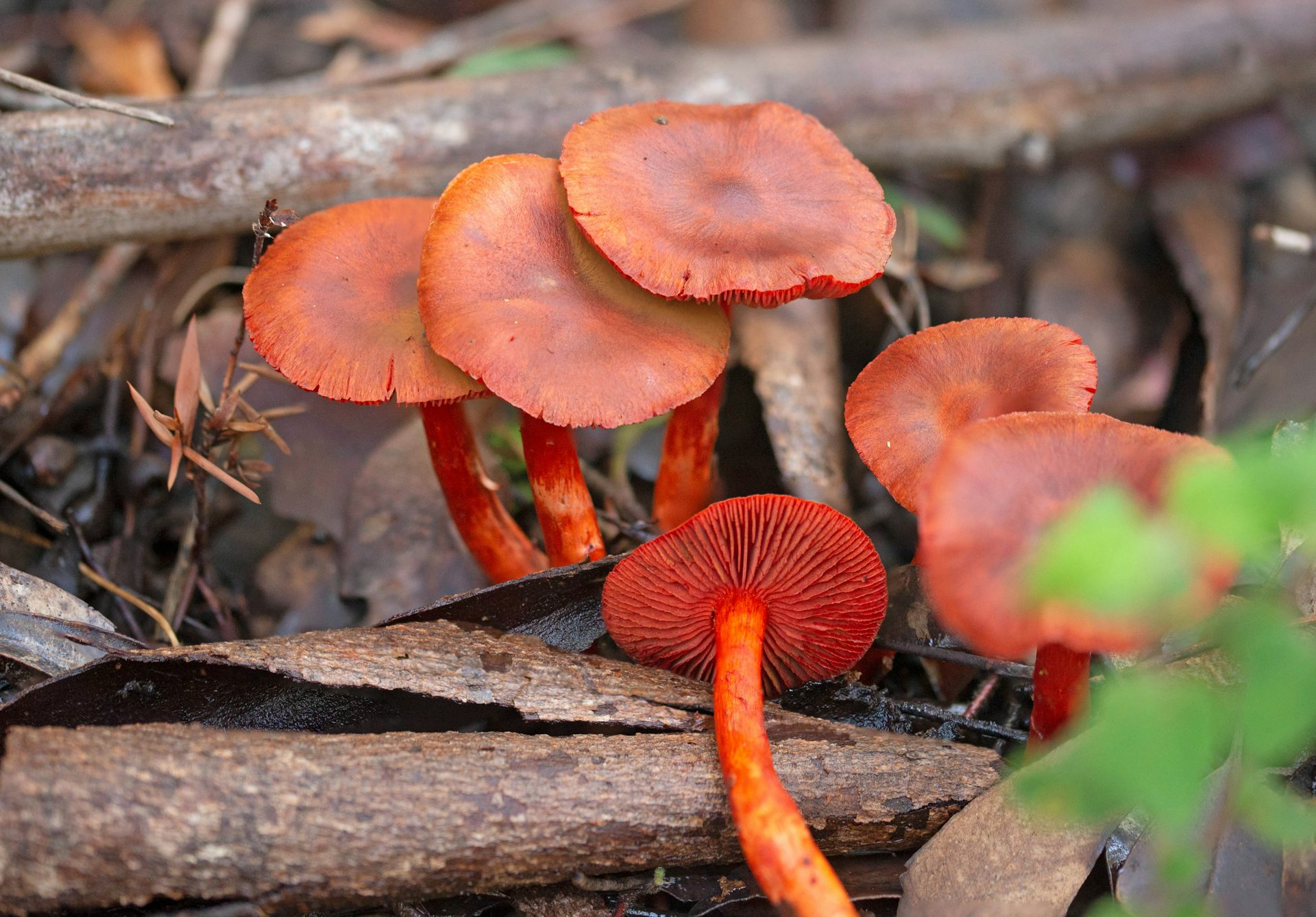 Gregory Moore, The University of Melbourne and Mark Brundrett, The University of Western Australia
Gregory Moore, The University of Melbourne and Mark Brundrett, The University of Western Australia
Environmental scientists see flora, fauna and phenomena the rest of us rarely do. In this series, we’ve invited them to share their unique photos from the field.
You may be familiar with the red toadstool with white spots, which are often the homes of fairies in children’s stories. These toadstools are also a small part of grander magical story: they are striking examples of mycorrhizas.
Mycorrhizas (pronounced my-cor-rye-zas) is the name for fungi associated with the root systems of many plants including trees, shrubs, groundcovers and grasses. These relationships are mutually symbiotic, which means both members benefit.
Fungi have a deeply ancient evolutionary origin, and colonised land with the first plants around 500 million years ago to form these partnerships. We humans often underestimate their importance to the ecosystems that have shaped life on earth.
So let’s take a closer look at how this relationship works and why it’s so important for Australian ecosystems.
An intimate relationship
Fungi come in a beautiful diversity of shapes, sizes and colours. The following photos by my co-author Mark Brundrett are just a few examples of those growing in southwest Australia.
Mycorrhizas are not to be confused with fungi that decompose dead plant matter (saprophytes) or those that cause disease (pathogens).
Saprophytes are fungi that recycle nutrients, and these can also be large and impressive. They can create tree hollows, which provide shelter for nesting birds and other animals such as possums.
The ethereal ghost fungus, for example, is a saprophyte. It famously glows green in the dark, and recycles nutrients in ecosystems by breaking down dead wood.
The primary role of mycorrhizas, on the other hand, is to provide resources such as phosphorus and nitrogen to flowering plants. They also effectively increase the absorptive surface area of the plant’s root system, allowing plants to take up much-needed water and nutrients so they grow better and more quickly.
In return, the plants provide carbohydrates, a product of photosynthesis, which mycorrhizas require to grow.
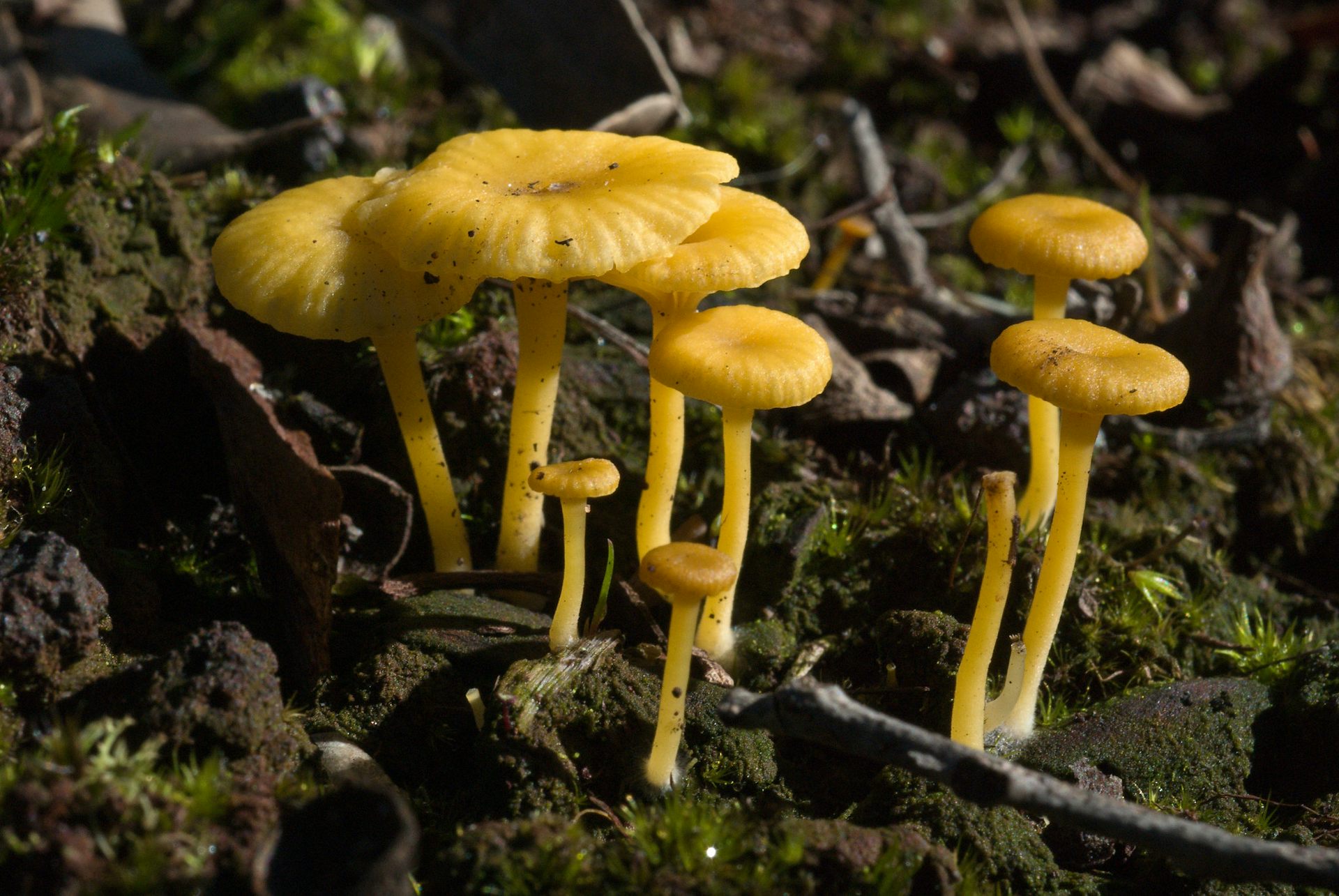
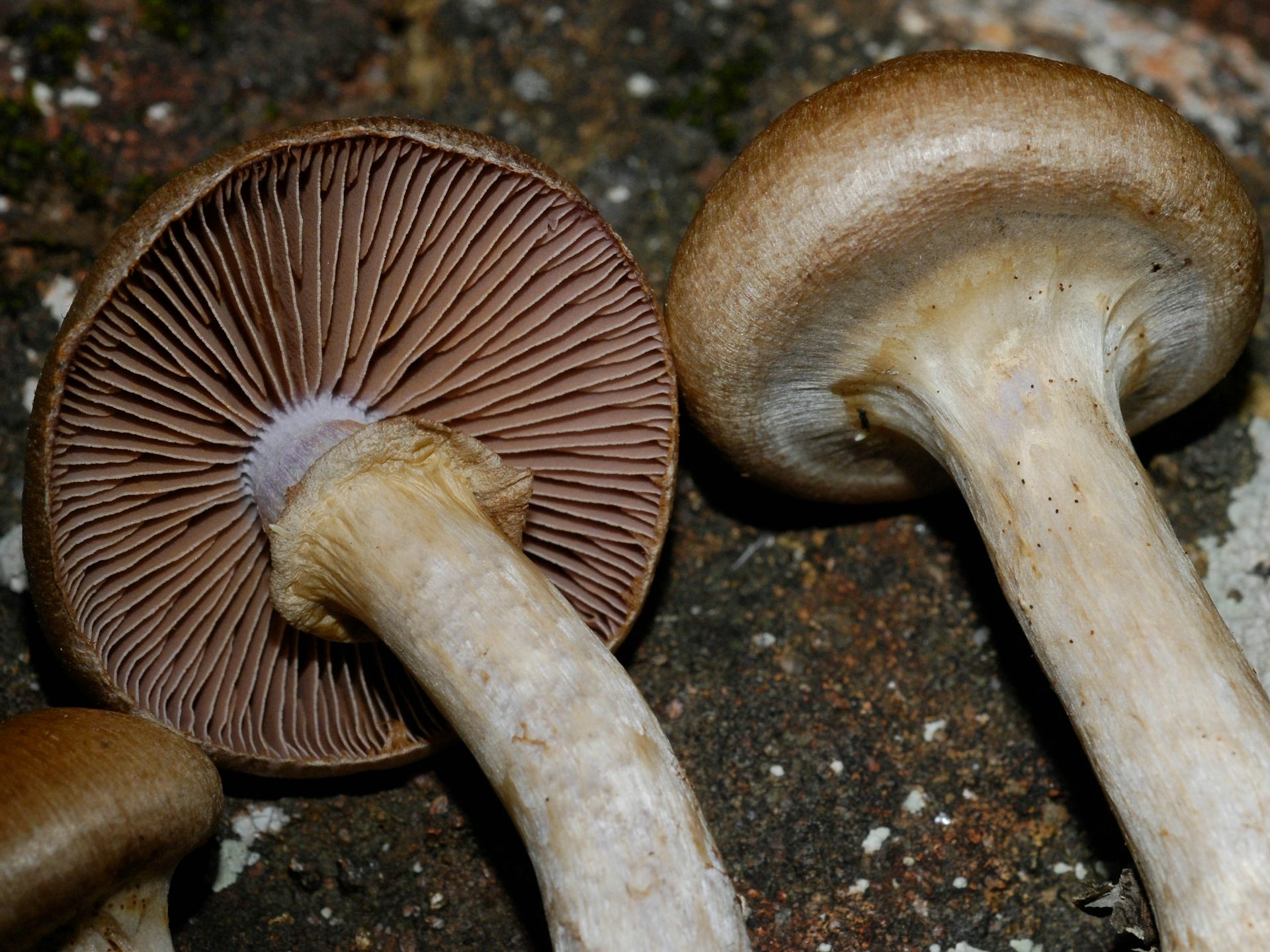
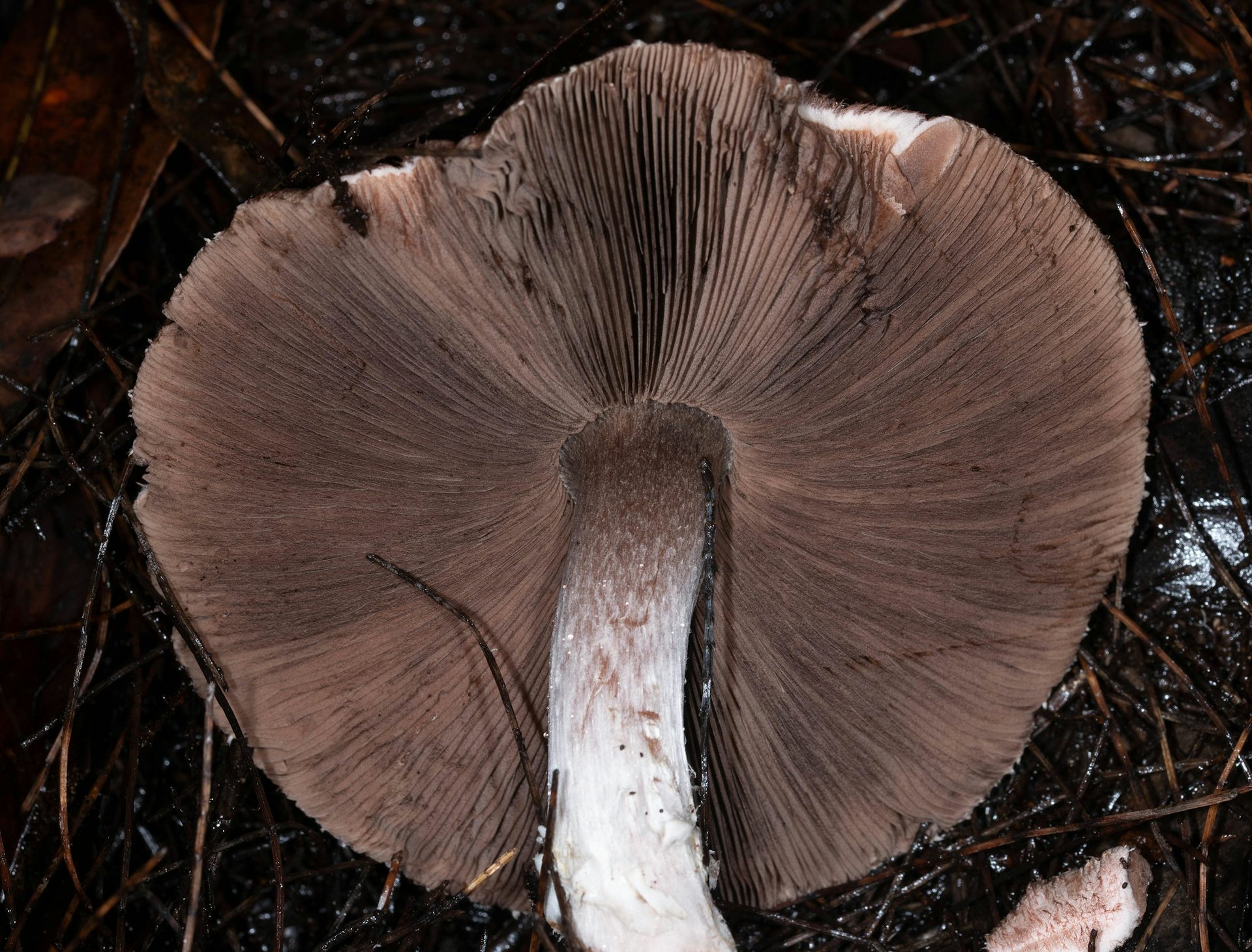 There are five different types of mycorrhizas, and two of these are particularly important in Australian ecosystems. One type is called “ectomycorrhiza”, where fungi wrap their hyphae (long, very fine hair-like structures that contact the soil) around the plant roots underground but don’t penetrate the root cells.
There are five different types of mycorrhizas, and two of these are particularly important in Australian ecosystems. One type is called “ectomycorrhiza”, where fungi wrap their hyphae (long, very fine hair-like structures that contact the soil) around the plant roots underground but don’t penetrate the root cells.
The other, called “endomycorrhiza”, is where fungi grow into the plant root, penetrating and branching within the root cells to form what look like little, microscopic trees. This is about as intimate a relationship between different types of organisms as you can get!

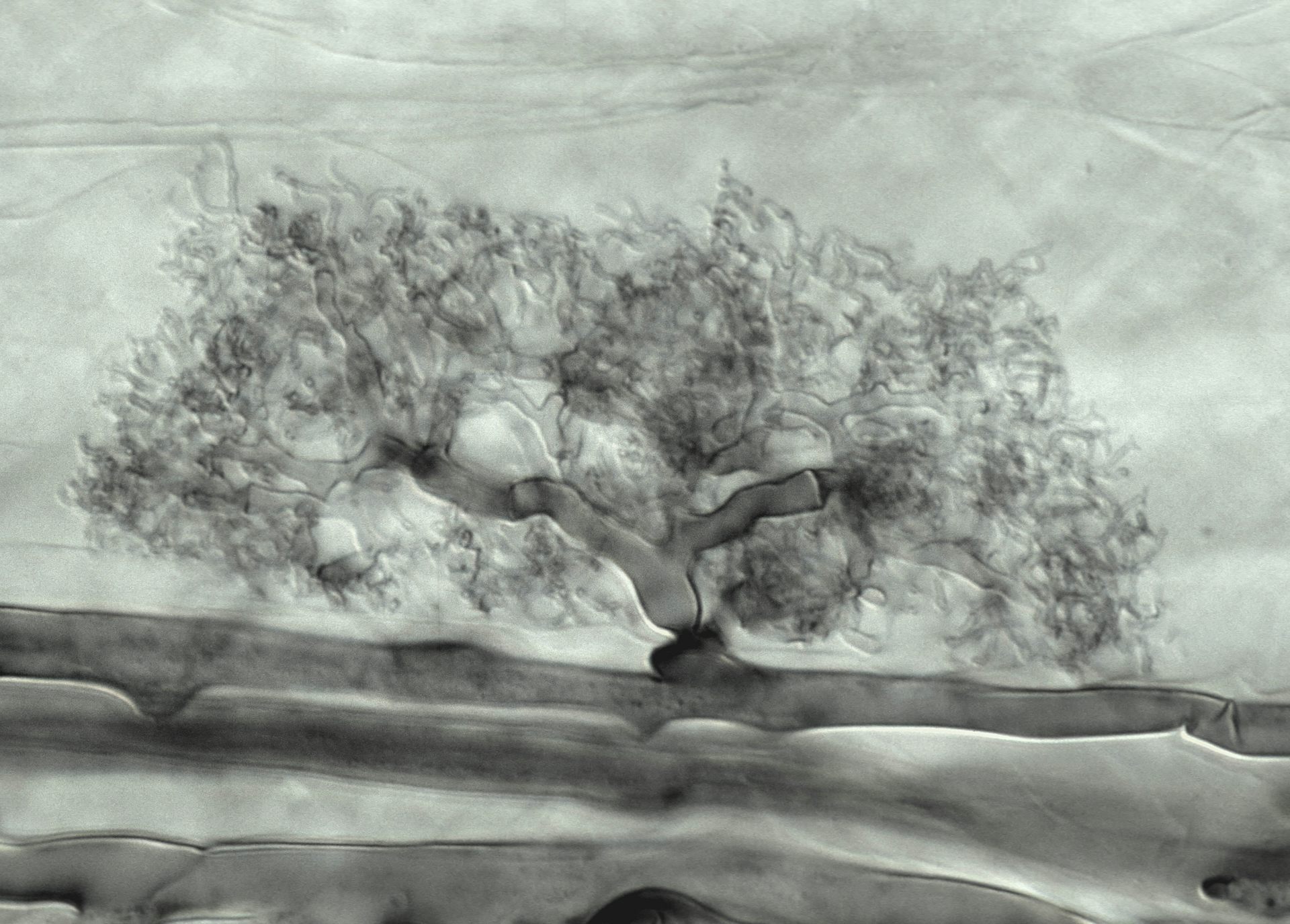 Mushrooms as big as dinner plates
Mushrooms as big as dinner plates
We often become aware of the presence of mycorrhizas only when conditions for reproduction are right, and a mushroom or toadstool emerges from the ground. Such conditions may only occur every five to ten years. For some species, there may be centuries between reproductive events.
For many of us, our experience with mycorrhizal fungi begins in very early childhood when we first catch sight of those spotty red and white toadstools, called the fly agaric or Amanita muscaria.
These fungi are often depicted in children’s book illustrations, such as Little Red Riding Hood, Jack and the Beanstalk, and a number of Enid Blyton’s tales. I recall conifers, such as pine trees, often growing nearby in the background of these pictures. This was no coincidence, Amanita muscaria forms mycorrhizal associations with many conifers, as well as oaks.
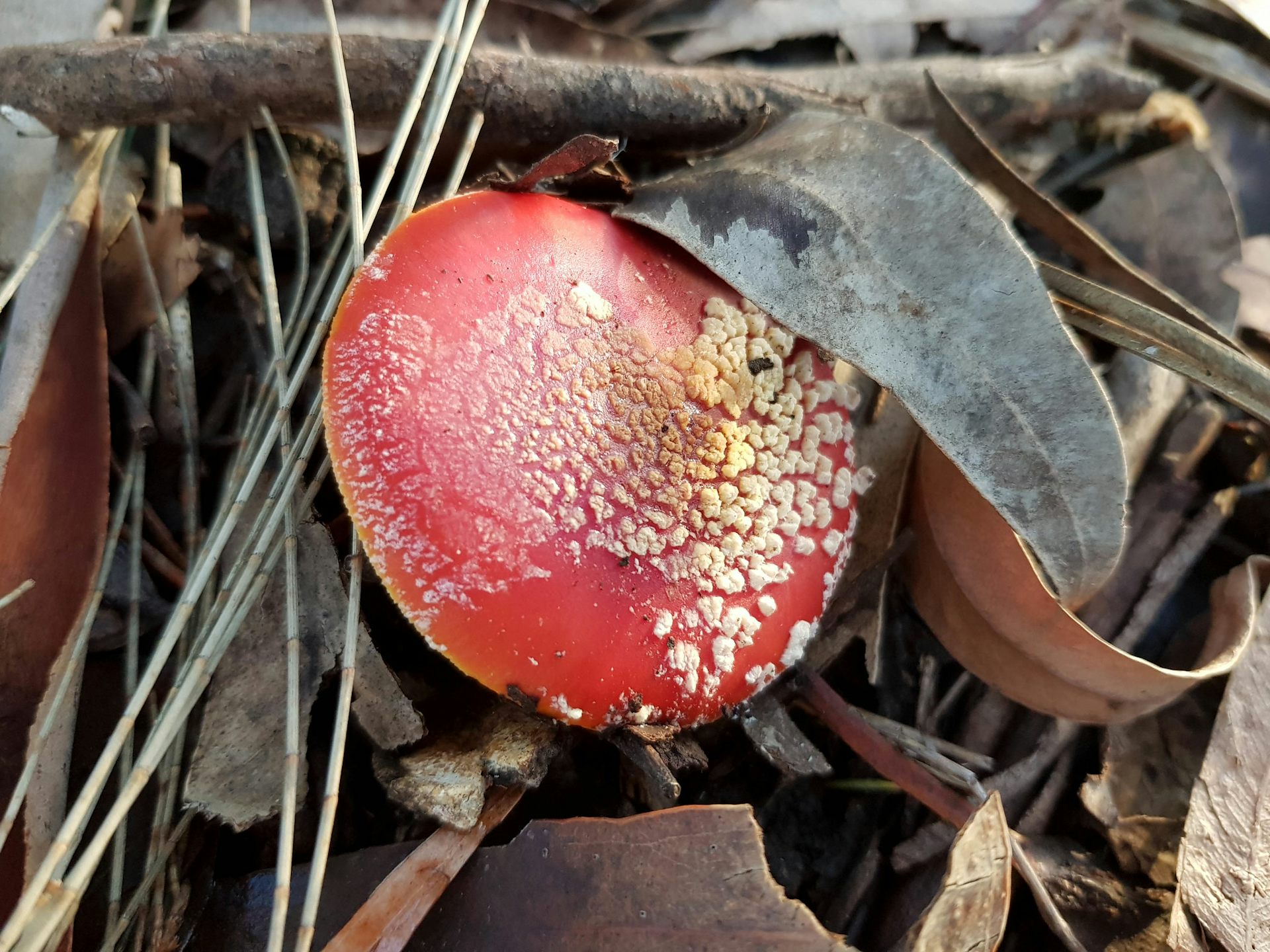
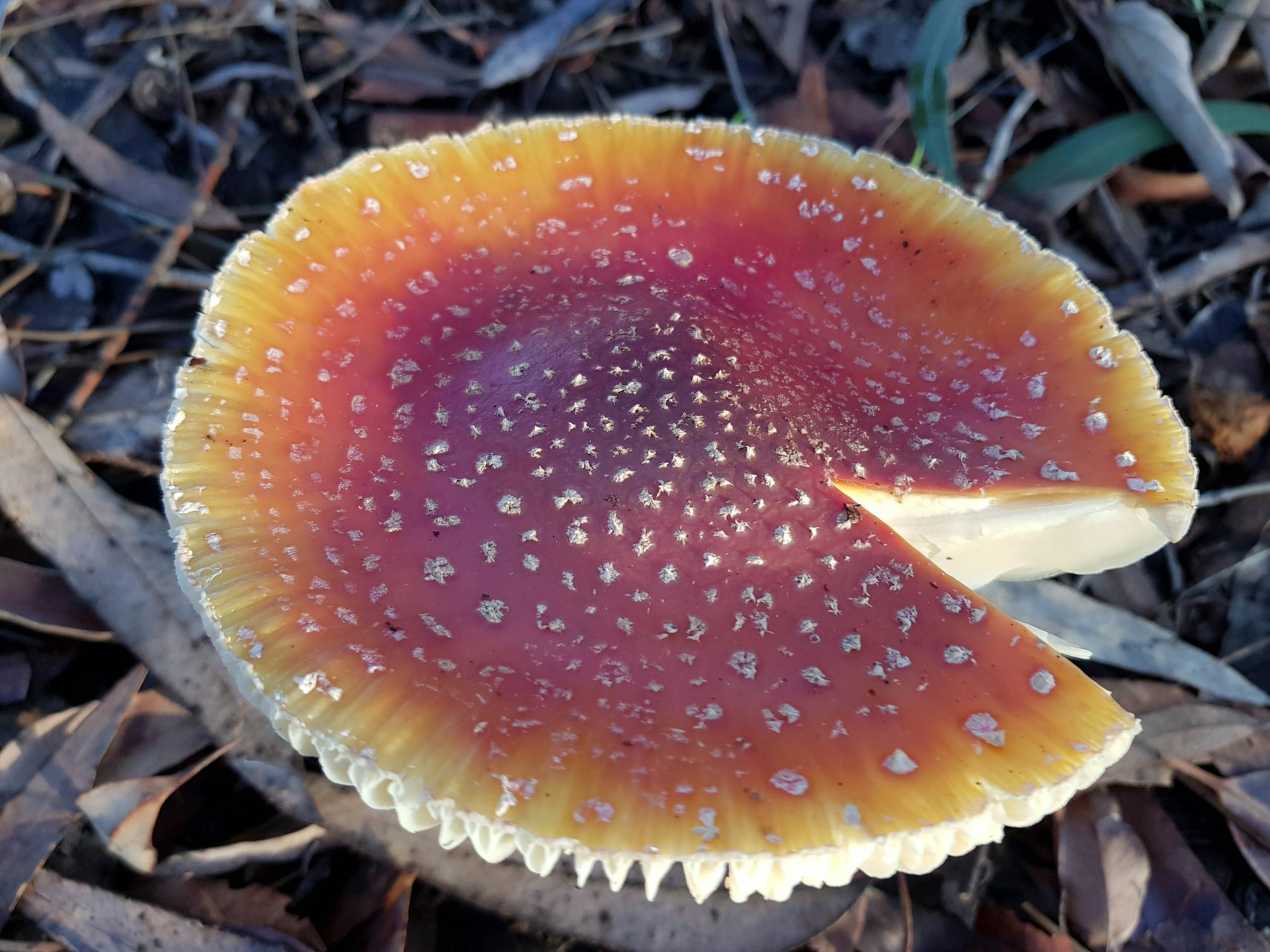 The mycorrhizal fungi associated with eucalypts can be less showy, with many being 75-100 millimetres across and a creamy, light tan in colour. They quite often pop up in home gardens, frequently in lawns, where they’re very obvious and usually within 4 to 5 metres of a tree trunk.
The mycorrhizal fungi associated with eucalypts can be less showy, with many being 75-100 millimetres across and a creamy, light tan in colour. They quite often pop up in home gardens, frequently in lawns, where they’re very obvious and usually within 4 to 5 metres of a tree trunk.
Others are spectacular, including the bright purple, orange or green Cortinarius species shown in the photos below. In fact, the beauty and diversity of our fungi now supports a new ecotourism industry in Australia, particularly in Tasmania.
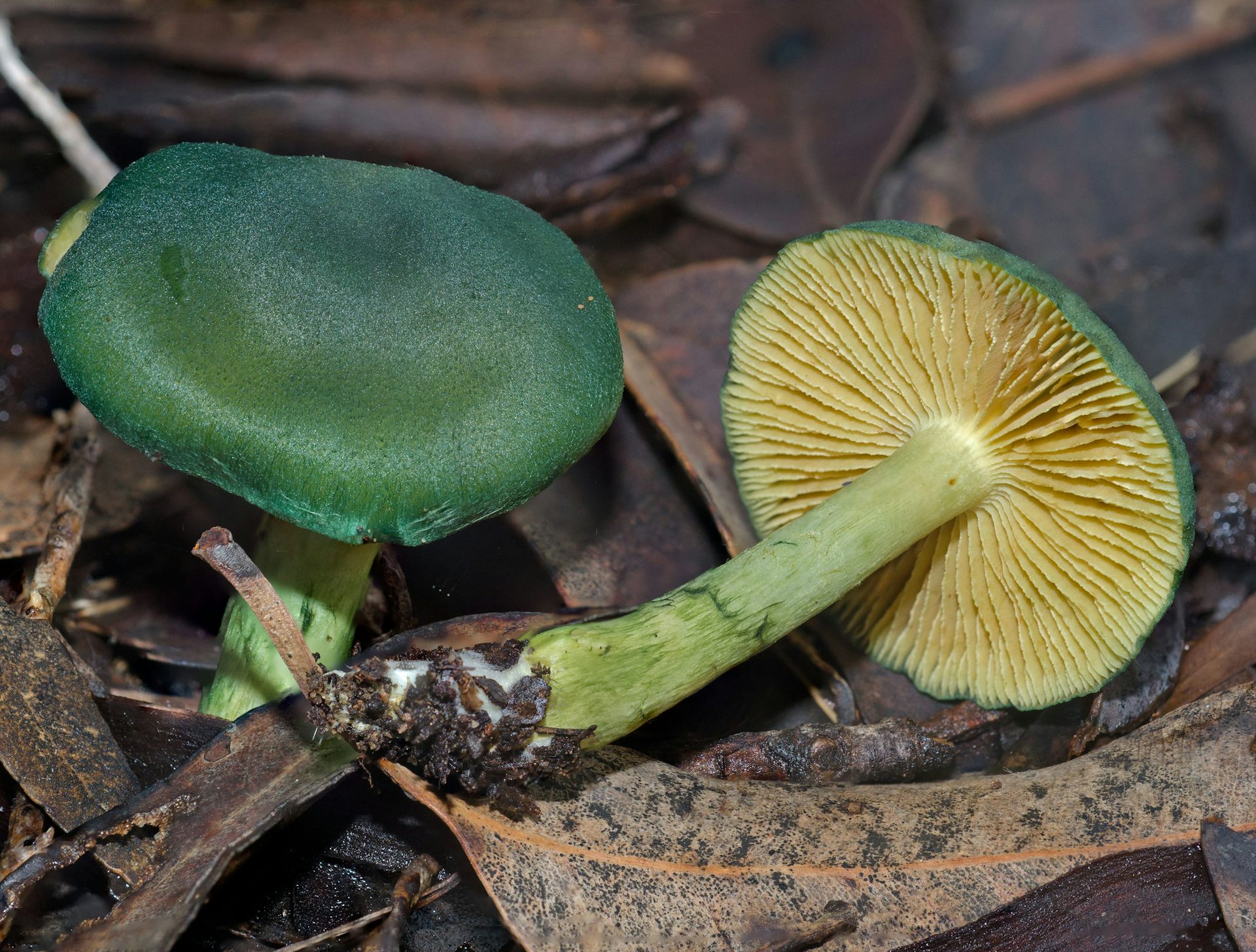
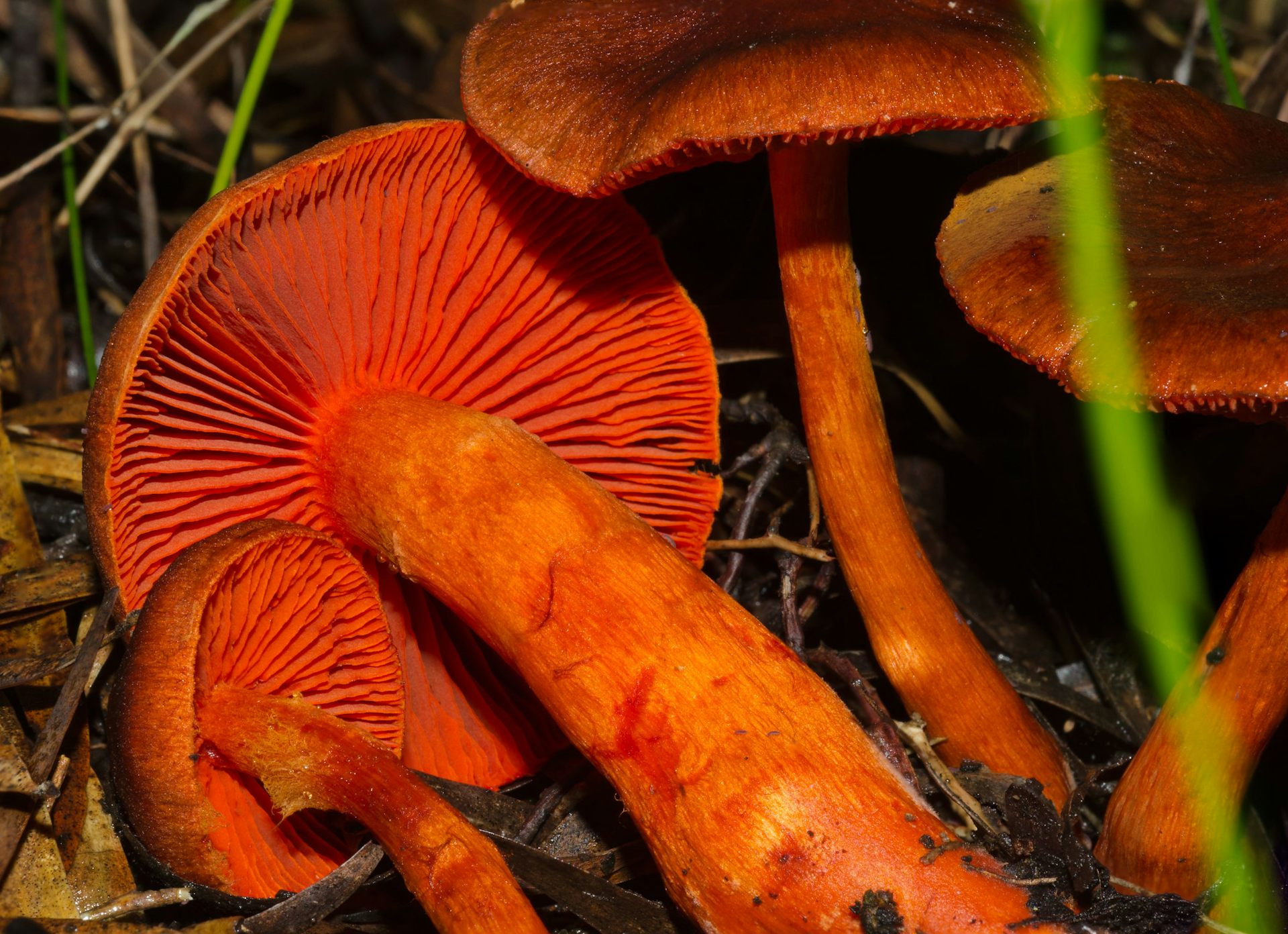
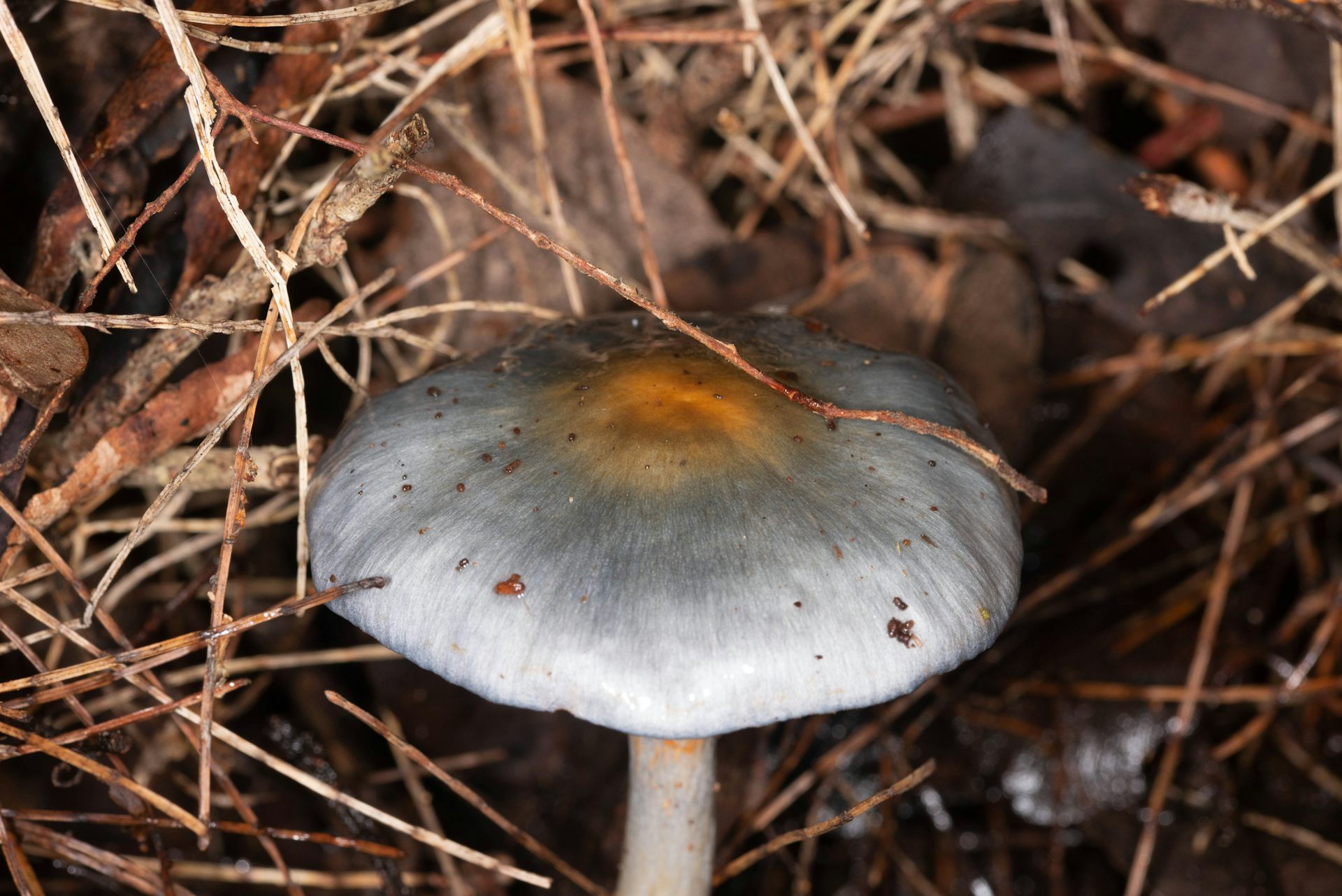 Some fungi are most impressive in the spring following bushfires, such as the abundant orange cup fungus shown below that stabilises ash beds.
Some fungi are most impressive in the spring following bushfires, such as the abundant orange cup fungus shown below that stabilises ash beds.
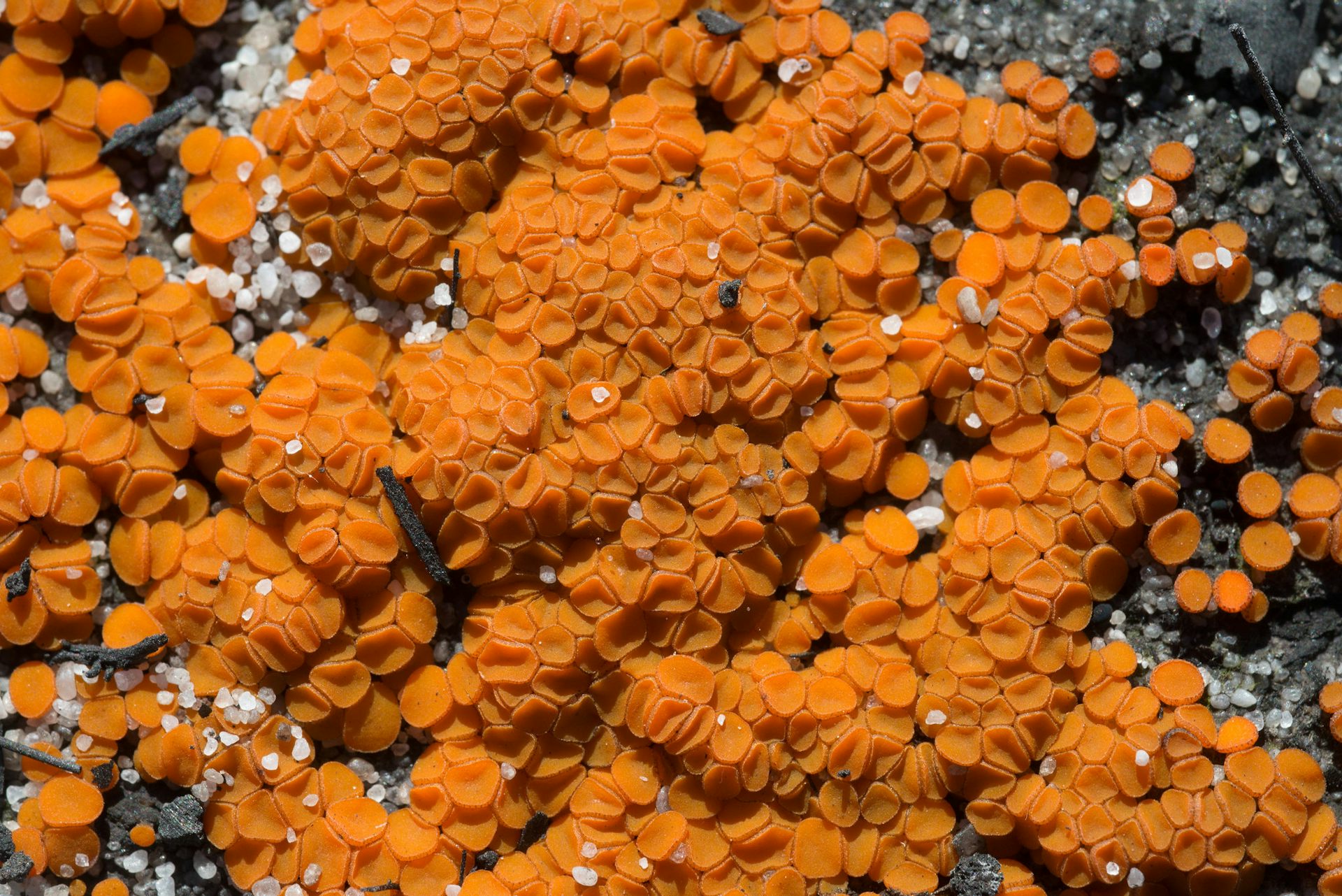 Indeed, most plants form mycorrhizal associations. Those that don’t include plants from the common vegetable families Brassicaceae (think broccoli, cauliflower, kale) and Chenopodiaceae (spinach, beetroot, and quinoa). Neither do members of the Proteaceae family, such as native banksias and grevilleas. These plants invest in very complex roots rather than fungal associations.
Indeed, most plants form mycorrhizal associations. Those that don’t include plants from the common vegetable families Brassicaceae (think broccoli, cauliflower, kale) and Chenopodiaceae (spinach, beetroot, and quinoa). Neither do members of the Proteaceae family, such as native banksias and grevilleas. These plants invest in very complex roots rather than fungal associations.
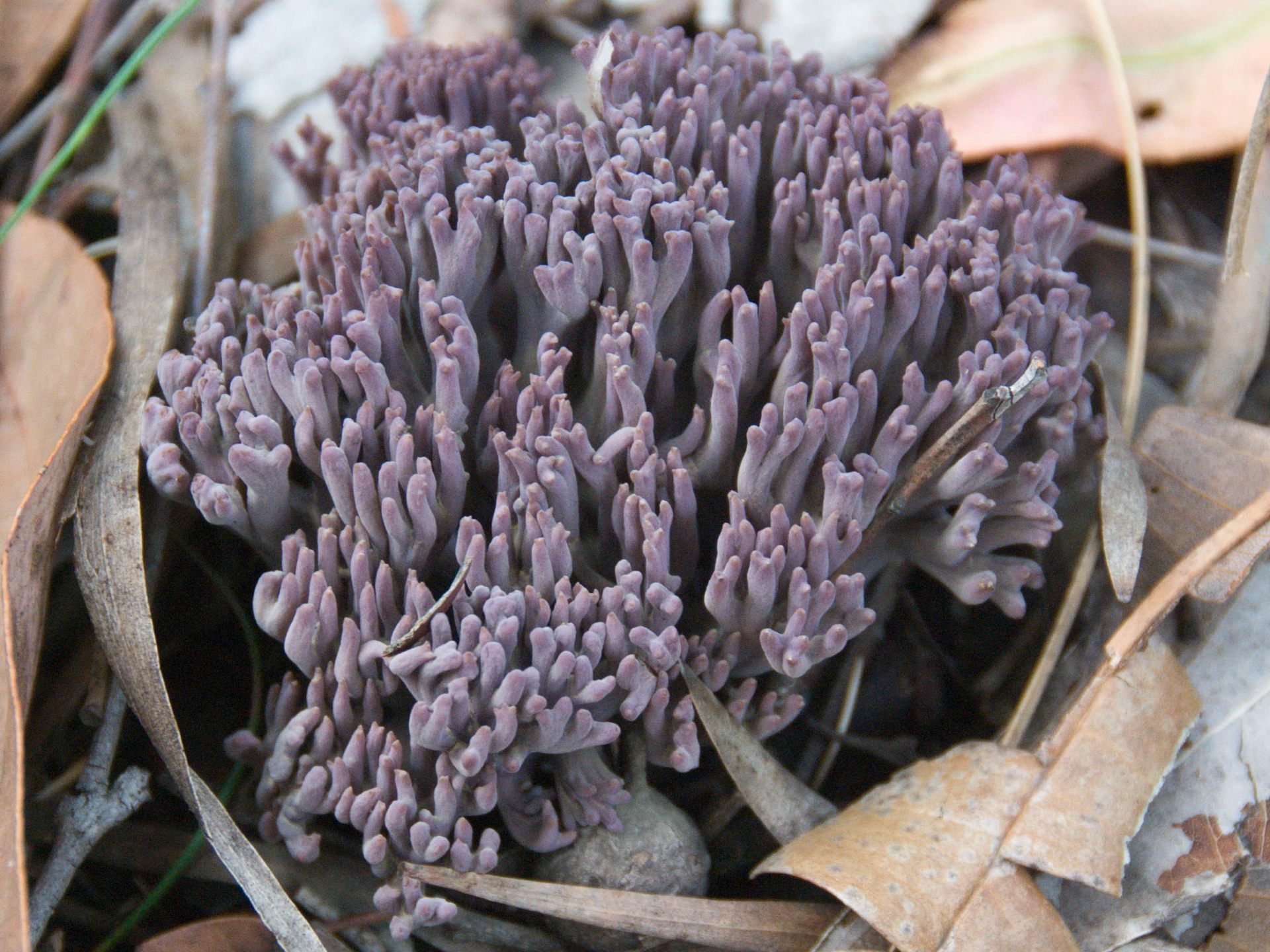
 Who’s really in control?
Who’s really in control?
Because we are so familiar with many of the plants in our environment, we are inclined to think it’s them that control their relationship with mycorrhizal fungi.
But it is possible mycorrhizal fungi exercise much more control. Or perhaps, the relationship is a perfect mutualistic symbiosis where partners share everything, including control, equally. We just don’t know yet.
Members of the fungus kingdom work in synchrony with the plant kingdom to support all terrestrial life, including animals such as ourselves. We may not think about fungi very often, but we cannot survive without them.
One of the surprise elements of Douglas Adam’s Hitchhiker’s Guide to the Galaxy, was that the Earth and its inhabitants existed as part of an experiment designed and controlled by white laboratory mice.
I sometimes wonder if the fate of the Earth’s terrestrial ecosystems rests on mycorrhizal fungi. If so, perhaps we need to show them greater respect.
 Gregory Moore, Doctor of Botany, The University of Melbourne and Mark Brundrett, Adjunct Associate Professor, School of Biological Sciences, The University of Western Australia
Gregory Moore, Doctor of Botany, The University of Melbourne and Mark Brundrett, Adjunct Associate Professor, School of Biological Sciences, The University of Western Australia
One of the most important symbiotic relationships on the planet is that between trees and fungi, without which we would have no trees, no forests, no timber, less oxygen and according to climatologists, very different weather patterns.
We would also not have all the species that depend on trees and forests which support one of the most diverse biota on the planet.
Trees themselves are an example of unintelligent design, as I explain in my book, The Unintelligent Designer: Refuting the Intelligent Design Hoax because their trunks and branches are the result of a massively wasteful arms race, as each tree competes with its neighbours to get its leaves above the canopy and into the sunlight. The result is a massive waste of energy and resource to build a structure which would have been unnecessary, had the ancestors of today's trees all being intelligently designed to stay at ground level and not compete for resources.
As a result of this unnecessary and wasteful complexity, another layer of complexity in the form of this symbiotic relationship between trees and fungi, which makes this possible, has evolved. Without it, trees could not obtain the nutrients they need or pump the water the leaves need to the top of the structure. So, from the perspective of the notion of intelligent [sic] design, we have massive waste and needless complexity to solve problems of the designer’s own incompetent making. So this relationship between fungi and trees represents one of the most glaring examples of the lack of foresight, planning and intelligence in whatever the design process behind it was.
From an evolutionary perspective, however, there is no need to explain bad design since there is no design process, as any intelligent person would understand it, involved. The result put the evolution of life on Earth on a trajectory that resulted in what we see today, and on which thousands of species are now dependent having evolved specialisations fitting them to live and survive in those niches by a process of co-evolving co-dependency - a predictable consequence of the process of evolution by natural selection.
The symbiotic relationship is between the roots of trees and the fungal hyphae in the soil, known as mycorrhizas. It is a lovely example of how Richard Dawkin's 'selfish genes' will form mutually beneficial alliances with the genomes of two or more organisms behaving like a single genome, albeit stored in different cells, co-evolving an every closer relationship, not of wasteful competition but of the more efficient cooperation, because cooperation benefits both organisms.
In another of the The Conversation series, 'Photos from the Field', Doctor Gregory Moore of The University of Melbourne and Associate Professor Mark Brundrett of the School of Biological Sciences, The University of Western Australia, explain this relationship, its evolutionary origins and why it is so important to the ecology of the planet. The open access article is reproduced here under a Creative Commons licence, reformatted for stylistic consistency. The original article can be read here:

The ancient, intimate relationship between trees and fungi, from fairy toadstools to technicolour mushrooms

Cortinarius kula
Credit: Mark Brundrett, Author provided
Environmental scientists see flora, fauna and phenomena the rest of us rarely do. In this series, we’ve invited them to share their unique photos from the field.
You may be familiar with the red toadstool with white spots, which are often the homes of fairies in children’s stories. These toadstools are also a small part of grander magical story: they are striking examples of mycorrhizas.
Mycorrhizas (pronounced my-cor-rye-zas) is the name for fungi associated with the root systems of many plants including trees, shrubs, groundcovers and grasses. These relationships are mutually symbiotic, which means both members benefit.
Fungi have a deeply ancient evolutionary origin, and colonised land with the first plants around 500 million years ago to form these partnerships. We humans often underestimate their importance to the ecosystems that have shaped life on earth.
So let’s take a closer look at how this relationship works and why it’s so important for Australian ecosystems.
An intimate relationship
Fungi come in a beautiful diversity of shapes, sizes and colours. The following photos by my co-author Mark Brundrett are just a few examples of those growing in southwest Australia.
Mycorrhizas are not to be confused with fungi that decompose dead plant matter (saprophytes) or those that cause disease (pathogens).
Saprophytes are fungi that recycle nutrients, and these can also be large and impressive. They can create tree hollows, which provide shelter for nesting birds and other animals such as possums.
The ethereal ghost fungus, for example, is a saprophyte. It famously glows green in the dark, and recycles nutrients in ecosystems by breaking down dead wood.
The primary role of mycorrhizas, on the other hand, is to provide resources such as phosphorus and nitrogen to flowering plants. They also effectively increase the absorptive surface area of the plant’s root system, allowing plants to take up much-needed water and nutrients so they grow better and more quickly.
In return, the plants provide carbohydrates, a product of photosynthesis, which mycorrhizas require to grow.

The yellow navel fungus Lichenomphalia chromacea forms a protective crust on soils in association with lichen fungi and algae.
Credit: Mark Brundrett, Author provided

Cortinarius vinaceolamellatus is a beautiful fungus that supports the growth of of tall eucalyptus forests.
Credit: Mark Brundrett, Author provided

This saprophyte is a relative of the common mushroom sold in shops (a species of Agaricus). Australian fungi can be toxic so leave them where they grow.
Credit: Mark Brundrett, Author provided
The other, called “endomycorrhiza”, is where fungi grow into the plant root, penetrating and branching within the root cells to form what look like little, microscopic trees. This is about as intimate a relationship between different types of organisms as you can get!

Microscopic cross-sectional view of an ectomycorrhizal pine tree root about 0.5 millimetres wide. This revels a labyrinth of black stained fungus hyphae surrounding root cells to form a nutrient exchange zone.
Credit: Mark Brundrett, Author provided

Arbuscular mycorrhizas are tiny tree-like growths inside the root cell where materials are exchanged with the host plant.
Credit: Mark Brundrett, Author provided
We often become aware of the presence of mycorrhizas only when conditions for reproduction are right, and a mushroom or toadstool emerges from the ground. Such conditions may only occur every five to ten years. For some species, there may be centuries between reproductive events.
For many of us, our experience with mycorrhizal fungi begins in very early childhood when we first catch sight of those spotty red and white toadstools, called the fly agaric or Amanita muscaria.
These fungi are often depicted in children’s book illustrations, such as Little Red Riding Hood, Jack and the Beanstalk, and a number of Enid Blyton’s tales. I recall conifers, such as pine trees, often growing nearby in the background of these pictures. This was no coincidence, Amanita muscaria forms mycorrhizal associations with many conifers, as well as oaks.

The fly agaric or Amanita muscaria is a striking fungus often seen in children’s books.
Credit: Mark Brundrett, Author provided

The fame of Amanita muscaria also arises from the hallucinogenic properties it sometimes has, but this fungus is most likely to have toxic consequences for those who eat it. It was also used as a natural insect killer.
Credit: Mark Brundrett, Author provided
Others are spectacular, including the bright purple, orange or green Cortinarius species shown in the photos below. In fact, the beauty and diversity of our fungi now supports a new ecotourism industry in Australia, particularly in Tasmania.

The bright green mushroom Cortinarius austroveneta is found in tall eucalypt forests.
Credit: Mark Brundrett, Author provided

Cortinarius erythrocephalus is another brilliantly coloured mycorrhizal forest mushroom.
Credit: Mark Brundrett, Author provided

Cortinarius rotundisporus, also known as the elegant blue webcap, can be found in southern Australia.
Credit: Mark Brundrett, Author provided

The orange cup fungus Anthrocobya muelleri is found briefly after severe fires.
Credit: Mark Brundrett, Author provided

This is a species of Ramaria, a mycorrhizal genus comprising approximately 200 species of coral fungi.
Credit: Mark Brundrett

Phlebopus marginatus is possibly Australia’s largest terrestrial mushroom, with one found in Victoria weighing in at 29 kilograms.
Credit: Mark Brundrett, Author provided
Because we are so familiar with many of the plants in our environment, we are inclined to think it’s them that control their relationship with mycorrhizal fungi.
But it is possible mycorrhizal fungi exercise much more control. Or perhaps, the relationship is a perfect mutualistic symbiosis where partners share everything, including control, equally. We just don’t know yet.
Members of the fungus kingdom work in synchrony with the plant kingdom to support all terrestrial life, including animals such as ourselves. We may not think about fungi very often, but we cannot survive without them.
One of the surprise elements of Douglas Adam’s Hitchhiker’s Guide to the Galaxy, was that the Earth and its inhabitants existed as part of an experiment designed and controlled by white laboratory mice.
I sometimes wonder if the fate of the Earth’s terrestrial ecosystems rests on mycorrhizal fungi. If so, perhaps we need to show them greater respect.
Subscribe to:
Posts
(
Atom
)





